Washington Trust for Historic Preservation

- Main Street
- Maritime Washington
- Most Endangered Places
- Public Policy
- Youth Heritage Project
- Preservation Trades & Consultants Directory
- Main Street Resources
- Learn With Us
- Trust Events
- PLACES Conference
- Board of Directors
- Stimson-Green Mansion
- Legacy Giving
- Corporate Partners
- Revisiting Washington
- Search Icon
- Privacy Policy
©2023 ALL RIGHTS RESERVED / 1204 MINOR AVE – SEATTLE, WA 98101 / P 206-624-9449 / F 206-624-2410

Carrying Traditions by Canoe: The Tribal Journeys Movement in Washington
October 6, 2022 | 10:27 pm
from Washington Trust
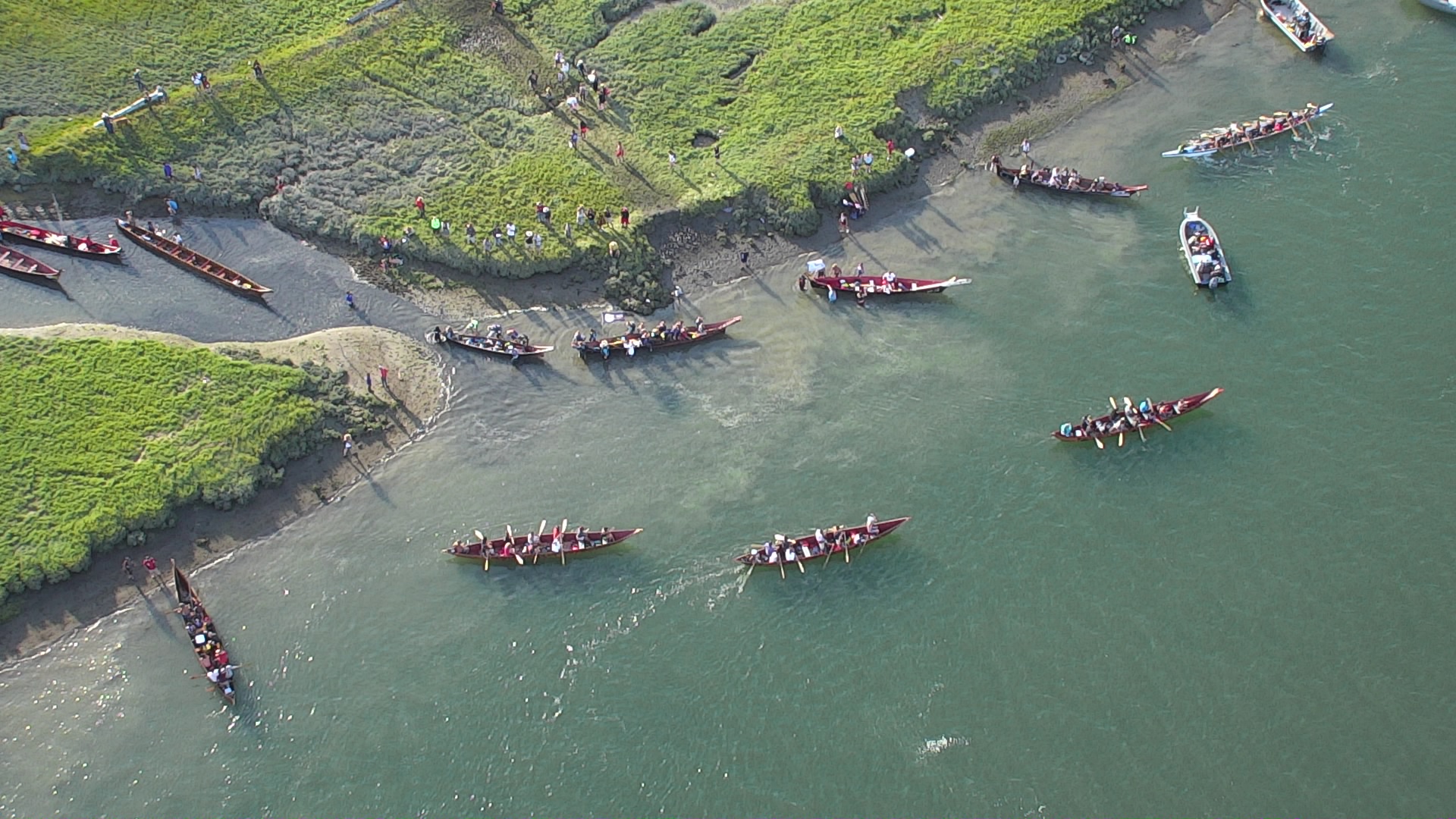
By Philip H. Red Eagle
Note: this article was originally published in the Fall 2020 issue of This Place magazine under the title “Tribal Journeys.” Image above: Canoe Journey 2019 landing at Swinomish, photo by Swinomish Police Department, courtesy of Swinomish Tribal Archive.
What we now know as Tribal Journeys started back in the 1980s and culminated in what would eventually be called “The Paddle to Seattle” in 1989 for the Washington State Centennial. The Paddle was initiated, constructed, and completed by our Elder Emmett Oliver (a member of the Quinault Indian Nation), who went to Governor Booth Gardner in the mid ‘80s and requested that there be Native American participation in the Centennial programming. The Governor gave Emmett the nod, and then Emmett began the return of the canoes and the beginning of Tribal Journeys.
In the now-famous “Paddle to Seattle,” multiple tribes carved big traditional canoes and paddled from the Suquamish tribal lands on Agate Pass to Seattle’s Golden Gardens Park. An immediate outcome of the Paddle to Seattle was a second canoe journey to Bella Bella in 1993. It was that journey that led to the development of a canoe protocol.
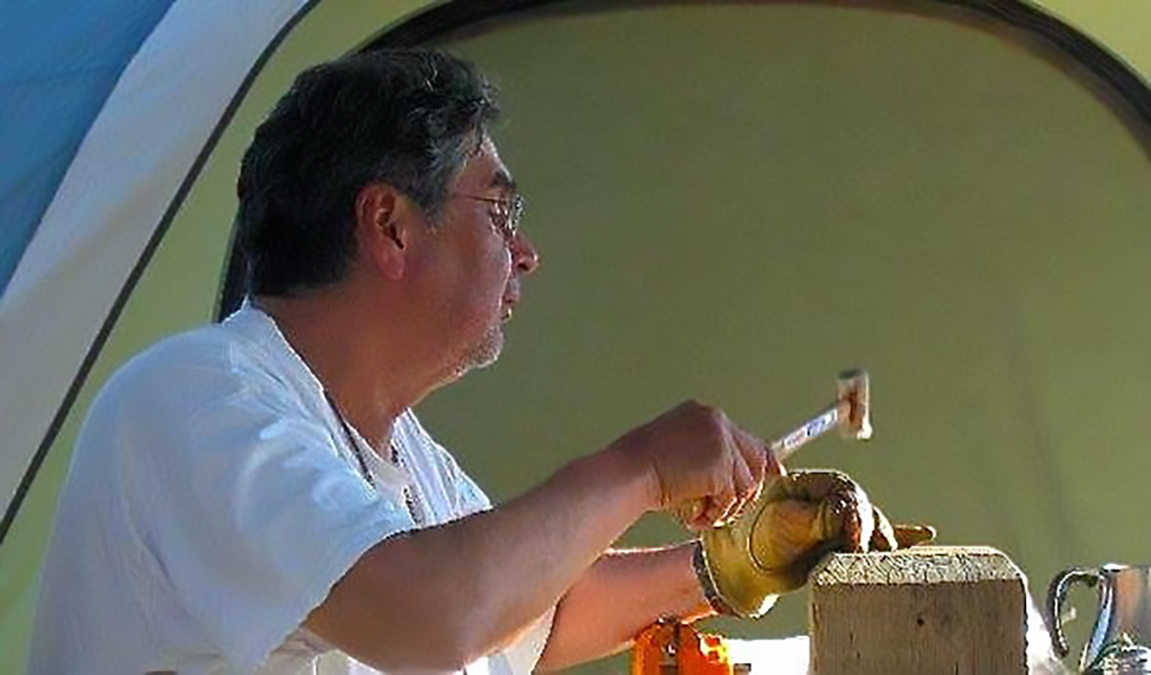
Another, and stronger, element of the program would be the use of Traditional Ceremonies handed down by the elders of many of the tribes in the region. It would be these ceremonies that would bind the various tribes and tribal organizations into a contiguous movement toward traditional values and processes. We also decided that these ceremonies and traditional practices would be placed in the canoe. The canoe would carry these practices and values and would teach the young people, and others who cared to learn, these elements.
In 1994, Tom Heidlebaugh and I, along with other members of the Cedar Tree Institute—a cultural advocacy organization formed by Tom Heidlebaugh— began looking for a way to teach culture to the local tribes and other Native individuals in the area. We decided that the canoe should play a vital role in the development of this teaching program.
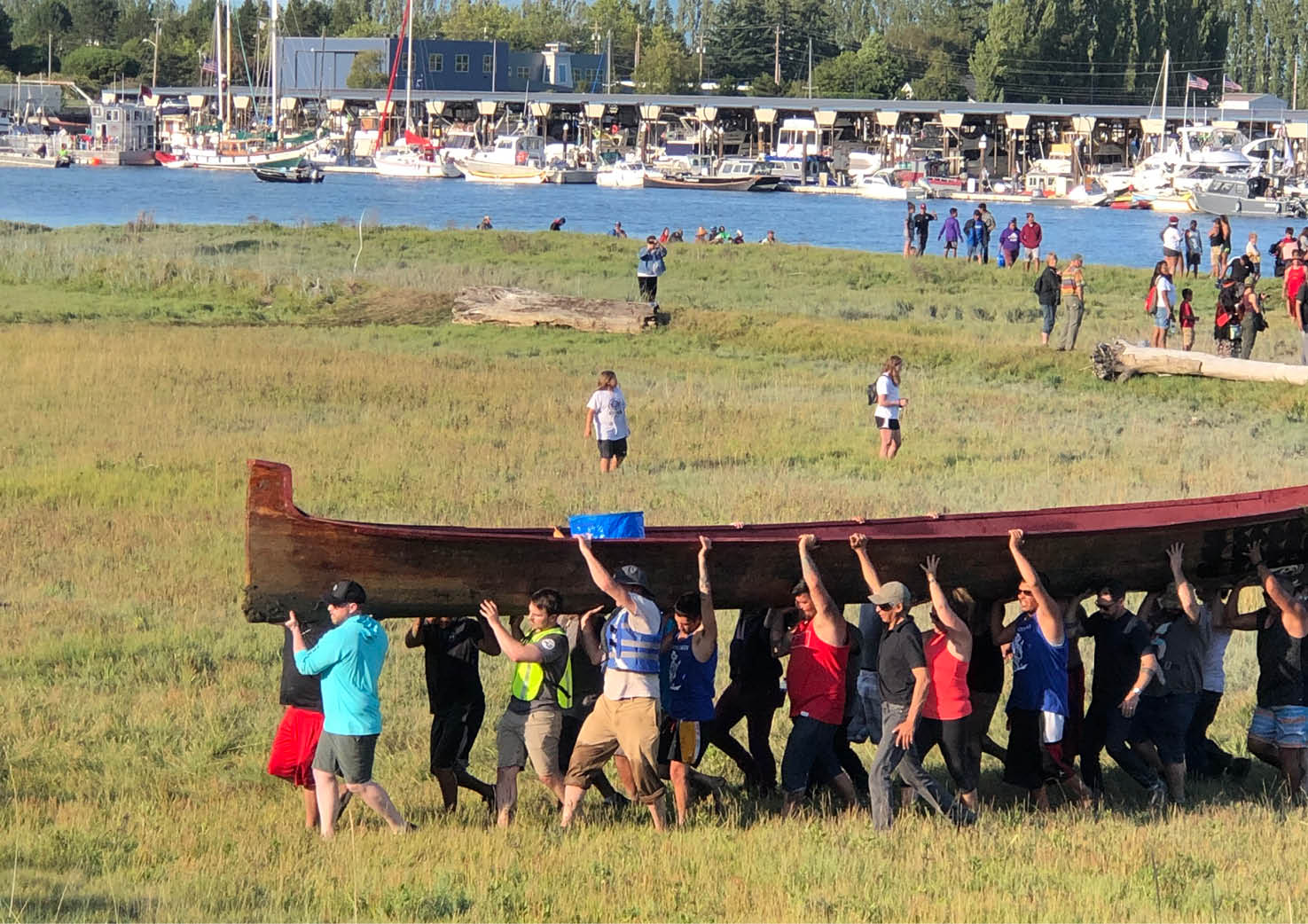
We also decided that each journey should begin with a ceremony. During the ceremony, each person on a canoe journey must promise to conduct themselves according to the following Ten Rules of the Canoe, which were developed and presented in Tacoma at the Northwest Experiential Education Association Conference in 1990 by Tom Heidlebaugh and David Forlines:
Rule One: Every stroke we take is one less we have to make. Rule Two: There is to be no abuse of self or others. Rule Three: Be flexible. Rule Four: The gift of each enriches all. Rule Five: We all pull and support each other. Rule Six: A hungry person has no charity. Rule Seven: Our experiences are not enhanced through criticism. Rule Eight: The journey is what we enjoy. Rule Nine: A good teacher always allows the student to learn. Rule Ten: When given a choice at all, be a worker bee–make honey!
The device for this ceremony is a copper ring necklace, and the ceremony is called the Copper Ring Ceremony. This copper ring is a constant reminder to each bearer of these ten rules. This “program” was first instituted in 1995 and 1996 while on a canoe journey titled the Full Circle Journey. This two-part journey around Key Peninsula started in 1995 with a paddle from the Skokomish Reservation to the Suquamish Reservation and concluded in 1996 with a second journey from Suquamish to Squaxin Island. There were three canoes and 50 participants on the first leg and seven canoes and 280 participants on the second leg. Ever since that journey, the Copper Ring Ceremony and the Ten Rules of the Canoe have remained a part of the annual Tribal Journeys. Tom Heidlebaugh died from cancer in 1997. I have made over 7,000 copper ring necklaces and conducted several hundred Ring Ceremonies since 1995.
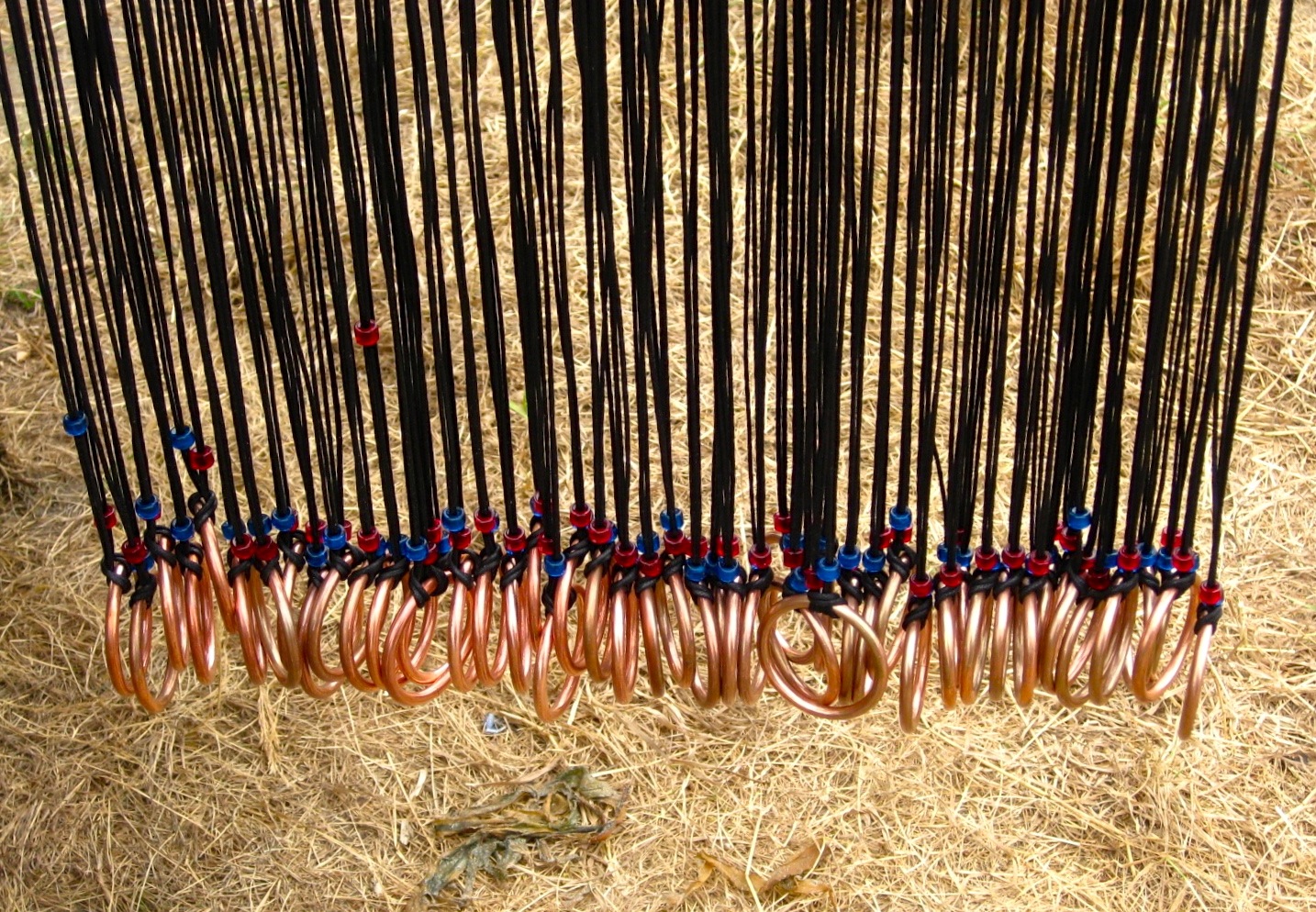
Currently, after 25 years of annual journeys, there are up to 125 canoes and 10,000 participants arriving at each Hosting, meaning the ending site and ceremony for the annual journey. Over those years there have been 23 Hosts. Tribal Journeys was canceled in 2020 to meet safety precautions for COVID-19, but planning is underway for 2021.
October 2022 update: full-scale Tribal Journeys did not take place in 2021 after all, nor 2022. However, plans are taking shape to bring back this unique and important tradition in 2023.
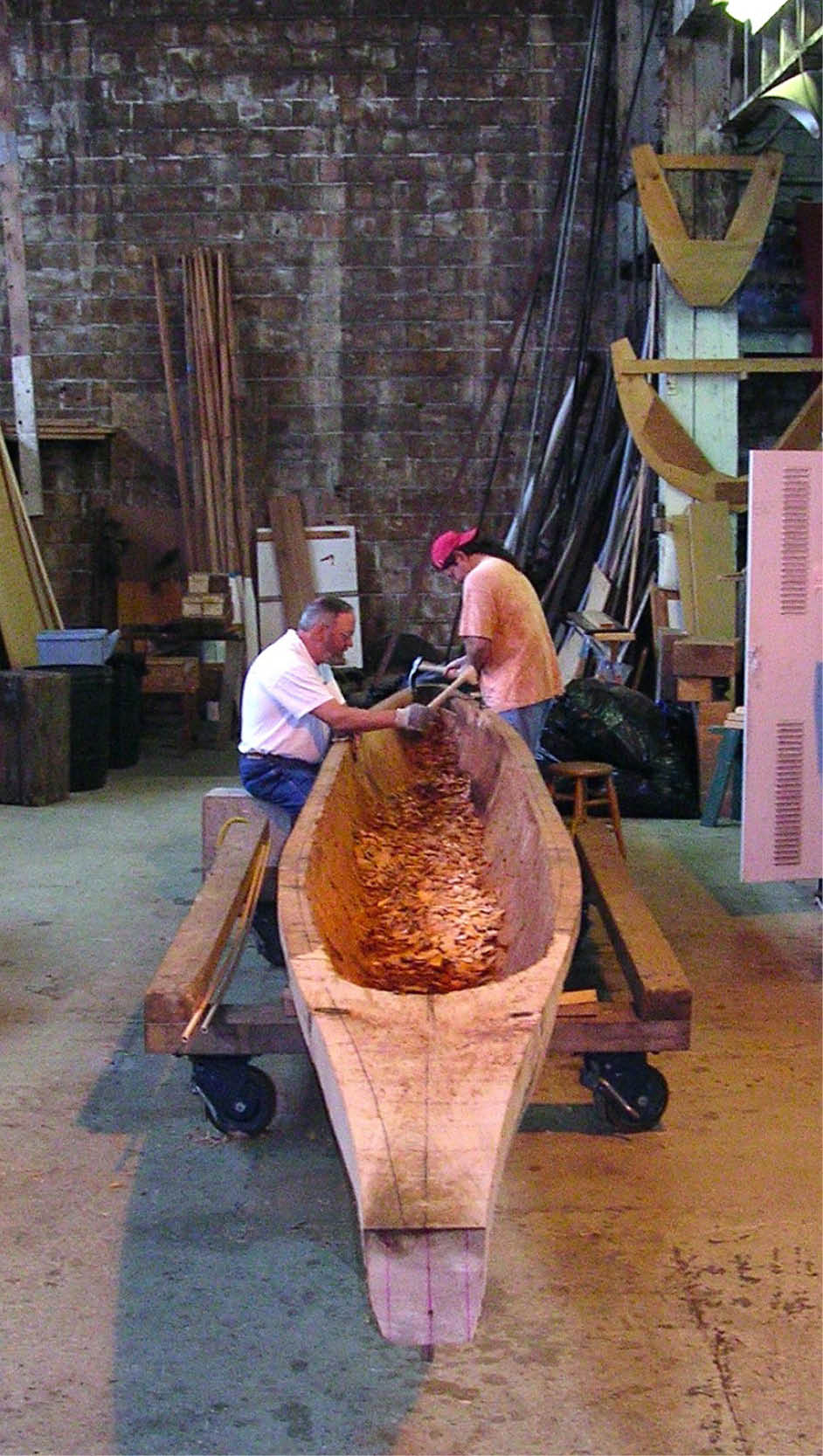
- fa-facebook
PUBLIC HISTORY PDX
A Project of the Department of History at Portland State University
Canoe and Paddle | Spirit and Energy of People Near Water
Canoes remain very significant to many Native communities along the Pacific Coast. Since 1989, indigenous people of the Northwest have joined together for the Annual Interntribal Canoe Journey, an activity that has grown and expanded into the twenty-first century. The first modern canoe journey was known as the “Paddle to Seattle” and was conceived of and organized by Emmett Oliver to commemorate the hundredth anniversary of Washington statehood. Known in the twenty-first century as the oldest living Quinault tribal member, Oliver is also a Chinook who was raised in South Bend, Washington on Willapa Bay. Mr. Oliver and participating tribes used the 1978 American Indian Religious Freedom Act to gain access to old growth trees that were used for some of the first new canoes made in many years along the coast of Washington. These communities held carving workshops, trained for long days of paddling, and prepared routes in their indigenous territories.

Today, the Canoe Journey often attracts upwards of 100 canoes with as many as 10,000 Natives participating. The canoes that travel represent canoe “families” and communities that have accepted the invitation from a host community to come to their lands. The journey requires physical and mental stamina, and is considered by many a spiritual journey. Canoe families consist of ground support as well as the actual “pullers” in the canoe. All work with one goal in mind, to get their canoe to the host community. Travelers are on the water for as long as a month and paddle between 10 and 40 miles daily as they travel from Native community to community or reservation to reservation. Twelve hour days are not uncommon. When arriving and throughout the visit, the travelers follow traditional protocols that include asking permission to come ashore. The host community provides a campsite, meals, showers, and takes care of every need of the visitors. After dinner the hosts open a “floor,” and it is the obligation of the visitors to share songs, dances and heartfelt words. When the canoes leave the shores of the host community, they are generally accompanied by the canoes from that community. This pattern continues until all the canoes arrive at the final host community where a large potlatch has been prepared. This usually takes the better part of a week to conclude. Oliver declared the journeys “an outstanding analogy of the spirit and energy of people who live near the water” when he recalled the history of the journey for a reporter in 2003.Canoes remain very significant to many Native communities along the Pacific Coast.
Video: Landing Day . Landing Day at Cowichan Bay | 2008 Longer videos—with narration, interviews, and music—are posted on the A Blending of Science and Tradition web site
Since 1989, indigenous people of the Northwest have joined together for the Annual Interntribal Canoe Journey, an activity that has grown and expanded into the twenty-first century. The first modern canoe journey was known as the “Paddle to Seattle” and was conceived of and organized by Emmett Oliver to commemorate the hundredth anniversary of Washington statehood. Known in the twenty-first century as the oldest living Quinault tribal member, Oliver is also a Chinook who was raised in South Bend, Washington on Willapa Bay. Mr. Oliver and participating tribes used the 1978 American Indian Religious Freedom Act to gain access to old growth trees that were used for some of the first new canoes made in many years along the coast of Washington. These communities held carving workshops, trained for long days of paddling, and prepared routes in their indigenous territories.
Canoe journey articles:
- A journey toward healing, by canoe Tribes gather after traditional canoe trip for ceremonies, circles to promote clean living Seattle Post Intelligencer article, 2003
- Northwest Indian Fisheries articles about Canoe Journey, 2009-2011
- Canoe Journey Carries Tribes to Connection with History ,” Seattle Times news article, 2011
- Tribal Journeys information | WordPress site for the tribes
- Tribal Journeys code of conduct
The Intertribal Canoe Journey revives the centuries-old traditions of transport and trade by the Coastal Tribes of the Northwest, many of whom traveled over open waters to meet and gather for festivities. Canoe Journeys have become a major catalyst for Native people to relearn, strengthen and reinforce their traditions. The Journey teaches people about canoeing, living, working, and achieving in a community. Canoe Journey builds pride in, and respect for, Native cultures.
Sam Robinson, Vice-Chairman of the Chinook Nation, describes the modern canoe journeys, their origin and meanings

As of 2014, the Chinook Nation has five canoes that are maintained for regular use. They are skakwal (lamprey eel), itsxut (black bear), and klmin (moon), ul-iymits (old nose) and yakanim (his canoe). Descendants of William Clark gifted the most recent canoe to replace one stolen from the Chinook by the Lewis and Clark expedition in 1806. In a moving ceremony at Chinook Point in 2011, members of the Clark family presented the Chinook Nation with a 36-foot canoe. The Chinook named the canoe klmin in honor of a Columbia River headman who once lived near Westport, Oregon. The name has roots in the Chinookan word for moon, a fitting name for a craft that will carry Chinook people on the tides of Pacific Northwest waters.
Joan Wekell, a member of the Chinook Nation Culture Committee, was one of the official witnesses at the canoe naming ceremony. Read her statement describing the day: “The Repatriation of the Canoe Stolen by Meriwether Lewis and William Clark in 1805.”
Video: Media coverage of the gifting of Klmin , from the Daily Astorian .
Tribal Journeys 2023: After three-year hiatus, canoe families pull to Muckleshoot

After a three-year hiatus, Tribal Canoe Journeys brought thousands of Indigenous people from across the Pacific Northwest and beyond to the Muckleshoot Indian Tribe for a week of celebration and culture.
Though the intertribal journey is normally an annual event, it had been on pause since 2019 because of COVID-19 restrictions. After a tough few years of getting through the pandemic, canoe families and their supporters were excited to get back on the water and for the preparations involved.

More than 100 canoes landed at Seattle’s Alki Beach in Muckleshoot homelands on July 30 — wrapping up this year’s Paddle to Muckleshoot and beginning a weeklong gathering involving sharing music, dance, food and following traditional protocol from July 31 to August 6.
Before landing, canoe families give an introduction and request permission to come ashore.

“We look forward to hosting you, to feeding you, to sharing songs and dances,” said Donny Stevenson, vice-chairman of Muckleshoot Tribe, as he welcomed the boats to his homelands.
“This week of celebration is something we’ve worked hard to prepare for. That we’ve worked tirelessly, over years, to be ready for this week. It’s with great joy that we receive every single one of you.”

The 1989 “Paddle to Seattle” was the first official canoe journey inspiring the revitalization of canoe culture and all the traditional practices involved in what’s now Tribal Canoe Journeys.
Canoe families begin their journeys from various starting points before landing in the host community, stopping along at other tribal communities along the way.

Daily canoe trips between host communities can involve as many as 11 hours on the water. Sunburn, wind burn and exhaustion make the journey worthwhile when they arrive and are greeted by their host communities with music, dance and traditional foods.

This year, coastal nations from as far as Alaska, Hawaii, and even New Zealand and the Indigenous Aniu community of Japan travelled to participate.
Other canoe families participated from across the Pacific Northwest including groups from Pacheedaht, Tsartlip, T’Sou-ke and many more.

On July 21, eight canoe families landed in Tsawout on “Vancouver Island.” One canoe family from Haines, Alaska made a total journey of more than 2,400 km, including paddling 290 km, before arriving in Muckleshoot.
Tlingit artist Wayne Price carved an eight-and-a-half-metre canoe from western red cedar in 2003, the first traditional dugout canoe he ever made. Twenty years later, Price participated in the journey with Skaydu.û Jules from the Eagle Killer Whale clan of Teslin Tlingit people in southern Yukon, Sarah Boyles-Muehleck who has been Price’s apprentice for the past two years and Patricia Chookenshaa Allen.

During the journey, they also held one seat vacant to honour those lost in residential school with an Every Child Matters flag waving at the mast.
When arriving to the shores of Muckleshoot, many people dedicated their journeys to lost loved ones.
Louie Tom of Tsartlip, who introduced his Moomooquin Canoe Family, spoke about how they lost their dad to COVID-19 in 2021 — and dedicated their journey to him.
“He was our skipper, our love, our strength,” he said.
“This year we’ve lost so much, our way of life, lost so many loved ones, we couldn’t be there for one another, the pandemic has taken a lot from us.”

While acknowledging the hardship of the last few years, canoe families also expressed gratitude for the ability to share culture and protocol. Many Youth also participated in the journey, including a Youth canoe from Kw’umut Lelum, an Indigenous child welfare agency based in Snuneymuxw.
“I want to raise my hands to the Youth on this canoe,” said Frankie Shaw, a cultural and recreational coordinator with Kw’umut Lelum.
“We’ve been working together for months and months to prepare for this journey, and the Youth have done nothing but impress me this entire time.”
The host nation for next year’s journey has yet to be announced.

Reporting for this story was made possible in part through a grant from the Institute for Journalism and Natural Resources and the Gordon and Betty Moore Foundation.

Margaret Benson
Margaret Benson is a Nuu-chah-nulth photographer who is based out of Victoria, B.C. She specializes in capturing documentary, music and event photos and is passionate about documenting culture through her work.
Related Stories

Haida Elder, who survived residential ‘school,’ alleges defamation from Catholic priest
Sphenia Jones is set to appear in 'Calgary' court on April 22 as she leads a proposed class action over what she alleges are 'false…
Read More »

‘Our children are so important to us’: Youth treatment centre set to open in Snaw-naw-as territories
The Orca Lelum Youth Wellness Centre will incorporate ceremony and culture into its healing programs, with a focus on identity and belonging

Tk’emlúps te Secwépemc signs ‘sacred covenant’ with the Catholic Church, marking ‘new journey of truth’
The new agreement not only acknowledges ‘past wrongs’ but outlines ‘practical commitments’ around continued investigation at KIRS, according to a statement
This site uses cookies to provide you with a great user experience. By continuing to use this website, you consent to the use of cookies in accordance with our privacy policy .

Building a Family through Tribal Canoe Journey

On a hillside in Suquamish, Washington, Nicole Kuhn and her two teenage sons watched brightly colored canoes make their way toward the beach below on a sunny July afternoon.
Kuhn was searching for a canoe with a colorful red and green salmon painted on its exterior. When she spotted the canoe, she teared up. Among the paddlers — called pullers — were her two older children, Ethan and Naomi, participating in their first Tribal Canoe Journey .

“We are Haida,” says Kuhn, a UW doctoral student. “Canoe culture is integral to who we are. I’ve been wanting to be part of a canoe family for years, and I’ve wanted to bring my kids into this for so long.”
Tribal Canoe Journey is an annual event that brings together tribal and First Nations communities to celebrate their shared heritage. Large canoes navigate the waters of the Pacific Northwest over days or weeks (depending on their starting point) before reaching the host tribe for a full week of protocol and celebration. This year the Muckleshoot Tribe hosted, with about 100 canoes arriving at the final destination — Alki Beach in West Seattle. Suquamish was one of the stops along the way.
Kuhn had watched canoe journey landings at Alki during previous summers, wishing she could participate. But she didn’t see a way. Her Haida relatives lived up north in British Columbia, Canada, and she was in Seattle raising four children.
To Kuhn's surprise, the University of Washington provided the answer.
Kuhn and her children are part of the new Shell House Canoe Family, č̓away̓altxʷ ʔiišəd, made up of UW students, alumni, faculty, staff, elders, and other community members. The group spent the past year planning its first canoe journey. They carved paddles, trained as pullers, learned songs and protocols, and coordinated complex logistics for each landing site. For many, it was their first time participating. For most, it won’t be their last.
Inspired by a Canoe
The story of the Shell House Canoe Family begins with a canoe. Not just any canoe — the Willapa Spirit Honor Canoe, once the honor canoe of Emmet Oliver (MEd, 1947), the guiding force behind the first Tribal Canoe Journey, the 1989 Paddle to Seattle. Artwork on the Willapa Spirit is by Emmet’s son Marvin Oliver, UW professor emeritus of American Indian studies, who passed away in 2019.
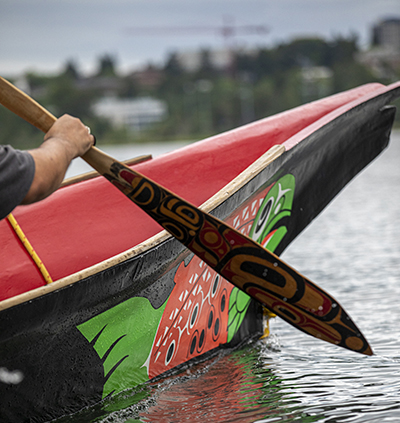
The Oliver family gifted the canoe to Emmet’s daughter Marylin Oliver-Bard (Quinault/Isleta-Pueblo) in 2018, and it has been housed at the University of Washington’s ASUW Shell House ever since. Oliver-Bard gifted the Willapa Spirit to the University in a formal ceremony during this year’s Tribal Canoe Journey.
Oliver-Bard hoped that having the Willapa Spirit at the UW would lead to a canoe family at the University. The UW's Center for American Indian and Indigenous Studies (CAIIS) helped that dream become a reality. CAIIS has dedicated substantial funding, staff support, and programming to realizing a University of Washington canoe family, while also welcoming other UW units into the process.
The College of Arts & Sciences is a strong supporter of CAIIS, providing more than a third of the Center’s UW funding. "The College is proud to support CAIIS's work to build community and connect students, faculty, and staff to Indigenous knowledges and peoples across the Pacific Northwest," says Dianne Harris, dean of the College of Arts & Sciences. The College’s Department of American Indian Studies (AIS) secured additional funding for the canoe family through a Mellon Foundation grant and offered a course about Tribal Canoe Journeys. Paddle carving workshops were held at the Burke Museum , also part of the College. The UW’s wǝɫǝbʔaltxʷ – Intellectual House contributed funds for the journey as well.
After the Willapa Spirit Honor Canoe was brought to the University, CAIIS Native knowledge-in-residence coordinator Philip Red Eagle (Dakota/Salish) started meeting with interested UW students, faculty, staff, and alumni to explore the idea of a canoe family at the University. As a leader in shaping Tribal Canoe Journey since the 1990s, he had decades of experience to draw from.
“My vision was to integrate a canoe family into the University system so that it would continue, with culture as a strong element of the curriculum,” says Red Eagle. “I wanted to involve as many people as possible — older people, more experienced people — so the students would have access to stories and advice.”
I wanted to involve as many people as possible — older people, more experienced people — so the students would have access to stories and advice. Philip Red Eagle Native Knowledge-in-Residence Coordinator, UW Center for American Indian and Indigenous Studies
An early recruit was Kariel Galbraith (Tlingit), an English and AIS major in the College of Arts & Sciences, born and raised in Sitka, Alaska. Also interested were Kuhn (BS, Informatics, 2019; MS, Information Science, 2022), a doctoral student in the UW Information School , and her son Ethan (Haida) (BS, Informatics, 2022).
“A lot of the early canoe family meetings were mostly Phil storytelling about his experiences with canoe journey, crazy stories that come with going on journeys for decades,” Galbraith recalls. “You don’t realize how much you learn from stories until you’re presented with information later and you realize you already knew it from hearing stories from someone who was there.”
A Complex Endeavor
Creating a canoe family was one thing. Preparing for Tribal Canoe Journey was quite another. For starters, the UW had a canoe but no appropriate paddles. To address that, Red Eagle offered paddle carving workshops at the Burke Museum , using traditional carving methods. Each paddle took more than 80 hours to complete.

“I wanted the students to experience a Native process,” Red Eagle says. “The students had to draw their design on the piece of wood, called a paddle blank, and try to find a paddle in that piece of wood, using hand tools.”
If that sounds straightforward, Galbraith can assure you it’s not. “Yellow cedar dries up as you keep working on it, so if you’re not consistently carving on it, it gets harder and harder and more difficult to work with,” she says. When Galbraith’s shoulder flared up from an old injury, others stepped in to help finish her paddle. “It’s been a really great collaborative effort to make sure everyone has a paddle when and if they need it for the journey,” she says.
With paddles completed, the pullers began training. They would be propelling the canoe from Tulalip to Suquamish to West Seattle, so becoming comfortable with the canoe and the paddles — and each other — was essential. (Relief pullers in a support boat were always available to swap places during the journey when needed.)

Behind the scenes, the canoe family’s ground support team worked on trip logistics. They reserved campsites, purchased supplies, and planned meals, noting dietary restrictions. During the journey, they set up tents, disassembled the camp each morning, packed up cars, checked ferry schedules, and transported everything to the next destination, all while keeping track of who was doing what each day.
“I’m a mom, so that was totally in my wheelhouse,” Kuhn says of her role as ground support. “Set up camp, clean up camp, and get people to places? Yeah, that sounds about right,” she laughs.
A Canoe Journey Course
The stress of planning the journey ratcheted up as summer drew closer. A spring quarter course offered by the Department of American Indian Studies helped ease students’ fears. “Introduction to Tribal Canoe Journeys” was taught by Nigel Lawrence (Suquamish), who at age 14 was a puller for the second-ever canoe journey, a month-long 600-mile paddle to Bella Bella, British Columbia.
“Right away, I saw the impact it had in my life,” says Lawrence (MEd, UW Tacoma, 2023). “Canoe journeys are drug- and alcohol-free events, like powwows. That’s stressed over and over. That was really important to me.”
There are so many things about understanding and relearning who we are that have come about because of canoe journeys. Nigel Lawrence Instructor, UW Tribal Canoe Journey Course
Tribal Canoe Journey has been central to Lawrence’s life ever since. In the past three decades, he’s missed only six journeys. He’s been skipper of the youth canoe for the Suquamish Tribe since 2001, and since 2010 has been part of Healing of the Canoe , a culturally grounded life-skills curriculum that uses the canoe journey as a metaphor for life.
In his UW course, Lawrence shared his own canoe journey experiences but also explored the impact of Tribal Canoe Journey more broadly.

“As canoe journeys got bigger and bigger, we started learning our language so we could ask permission to come ashore in our language or welcome guests in our language,” Lawrence says. “We made cedar bark or wool woven regalia for the ceremonies. There are so many things about understanding and relearning who we are that have come about because of canoe journeys. That was a central theme of the class.”
Guest speakers included Oliver-Bard, Red Eagle, and UW Regent Leonard Forsman, chairman of the Suquamish tribe. Lawrence also invited his mother, storyteller Barbara Lawrence, and Robin Little Wing Sigo, who created the Healing of the Canoe curriculum, among other guests.
For Galbraith, hearing from Native leaders with years of experience was heartening. “Having them offer guidance and ideas really helped in terms of easing stress and pressure,” Galbraith says, noting that Red Eagle was particularly encouraging. “Something he’d say pretty regularly was, ‘It’ll happen. Things will work out. They just work out.’ I took that to heart. If there’s anyone who knows you’re going to make it on a journey, that would probably be Phil Red Eagle.”
Intertribal Considerations
Red Eagle did more than offer words of encouragement. During the canoe journey, his Carvers Camp Canoe Family took the UW’s Shell House Canoe Family under its wing. The two groups camped together, canoed together, and shared a support boat, which helped tremendously. Yet the Shell House Canoe Family faced challenges beyond the physical journey, most notably how to navigate protocol — the celebration at the end of the journey.
At protocol, each canoe family performs traditional songs and dances for several hours, often wearing the regalia of their tribe. But the UW’s Shellhouse Canoe Family is intertribal, with representation from diverse communities, each with their own traditions. That complicates decisions about what to sing, what to wear, and what dances to share.
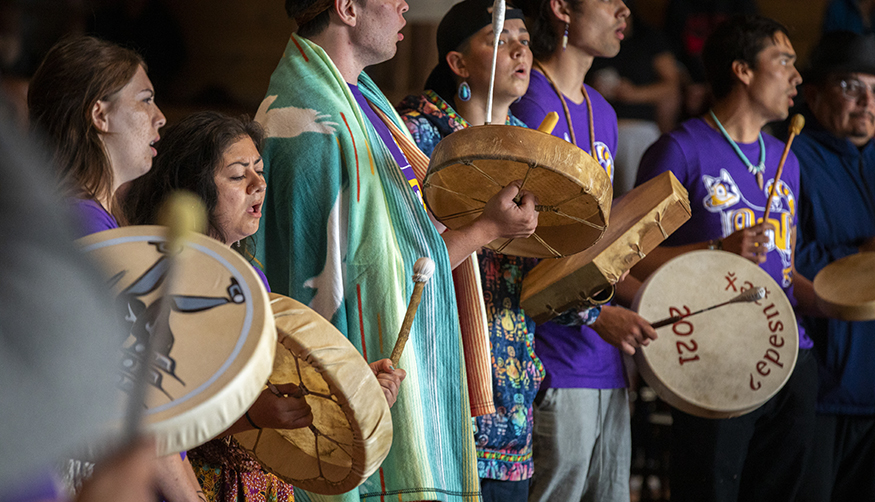
“It raises questions about how to keep yourself responsible to your own community and to this new community that you have,” says Galbraith. “For example, what does it mean to be given permission to sing songs that are not in your Native language?”
Even requesting permission to sing those songs is complex. Often, songs are owned by a community or family or clan. “We’ve all been invited as canoe family members to bring a song from our community,” says Kuhn, “but there are songs that I could sing as a Haida with other Haidas that I couldn’t necessarily have another group sing with me. I don’t have permission.”
John Smith (Skokomish) generously gifted the song Qway'at, which the UW canoe family sang when Oliver-Bard gifted the Willapa Spirit to the UW. AIS professor Tami Hohn (Puyallup) shared a Language Power song, which the canoe family performed at protocol. Hohn co-wrote the song — in Lushootseed, the language of the Coast Salish people — with Nancy Jo Bob (Lummi). Hohn also spoke to the gathered crowd at protocol about the history and vision for the UW’s Shell House Canoe Family.
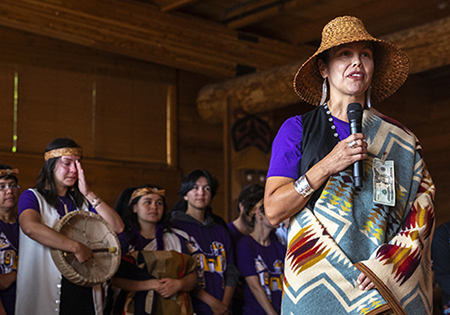
“Tami’s speech had the room in tears,” says Galbraith. “She spoke about intergenerational teachings and how, even just by singing the Language Power song, we’re helping to keep the Lushootseed language alive.”
There were other opportunities for members of the UW canoe family to celebrate their tribal identities. At each landing, canoes ask permission to come ashore in their Native language(s). And during protocol, individuals introduce themselves in the language of their people, which inspired some students to begin studying their Native language.
Kuhn, who has studied Haida for several years, had a chance to share her language during a special celebration in Suquamish, Washington, when Marylin Oliver-Bard officially gifted the Oliver family canoe to the University. Kuhn stood as one of the witnesses for the gifting and spoke as part of the ceremony — in Haida.
“As a Native person, learning our own languages again can be intimidating but also very powerful,” Kuhn says. “Having my kids witness me speaking Haida in public, and then to reflect on that moment with them, was very special for me.”
Continuing the Tradition
A day after the Willapa Spirit arrived at Alki, UW pullers returned it to the UW Shell House, its permanent home. Galbraith, who provided ground support throughout the journey, traveled in the canoe during its last leg. Ethan Kuhn was also in the canoe as it left West Seattle where he grew up and arrived at the UW where he studied for years.
“It was really beautiful, connecting these dots in our lives in so many ways,” says Nicole Kuhn, who watched with her other children as the canoe arrived at the ASUW Shell House. Her daughter Naomi, not currently a UW student, was able to participate as a relative of the canoe family. Being welcomed into the UW’s Native community in this way, she is now eager to transfer to the University of Washington.

Hear from members of the Shell House Canoe Family and watch the tribal canoe journey unfold in this University of Washington documentary video.
Enable Javascript to view the video embed or view the video directly at https://youtube.com/watch?v=adb8K2vqfJY .
Other participants are already thinking about lessons learned for the next canoe journey. With alumni encouraged to continue and pass along their knowledge, the Shellhouse Canoe Family will only grow stronger in future years.
“I’m so thankful that the canoe family is open to alums,” says Kuhn. “I hope that I’m always part of it. The experience feels so meaningful to us as Native students. That it’s connected to the University — that’s been really powerful.”
The Center for American Indian and Indigenous Studies, which made the canoe journey a reality, offers programs to support the recruitment, retention, and success of Native and Indigenous students, staff, and faculty through partnerships across campus and beyond. Funding for CAIIS comes from the Mellon Foundation and the University of Washington, with the College of Arts & Sciences providing about one-third of the UW funding.
More Stories
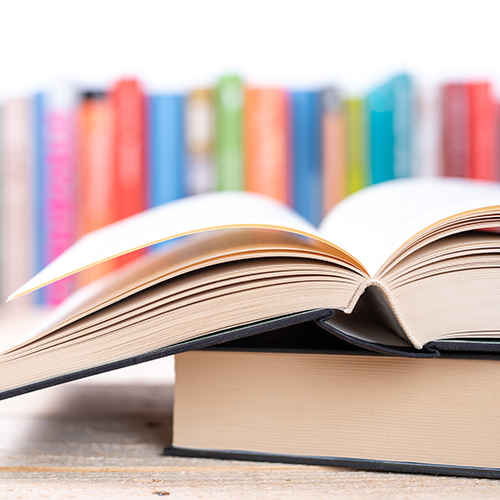
Exploring Connections Through Global Literary Studies
The UW's new Global Literary Studies major encourages students to explore literary traditions from around the globe and all eras of human history.
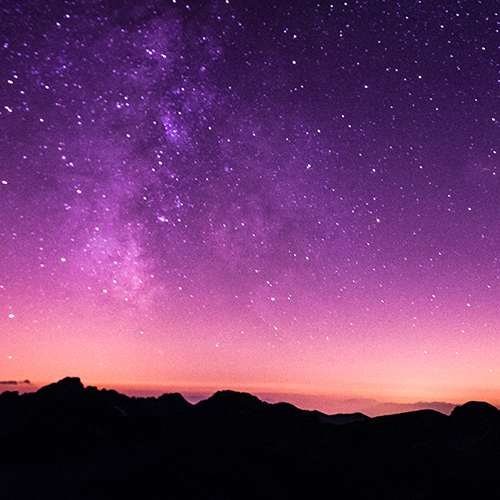
What the Sky Teaches Us
Brittany Kamai, an astrophysicist with knowledge of Pacific Islanders' Indigenous navigation using the sky, is teaching a new UW course, Pacific Indigenous Astrophysics.

Two Majors, Complementary Skills
Elizabeth Xiong (2024), a double major in art history and computer science, shares how she gained different and complementary skills from each major.
Explore Stories Across Arts & Sciences Departments
- Social Sciences Division
- Center for American Indian and Indigenous Studies
- Department of American Indian Studies
- Interdisciplinary
- UW and the Community
- Equity, Justice and Inclusion (EJI)

Tribal Canoe Journeys: Strength in Tradition
Movement // People
by Vanessa Chin, Maritime Washington Storytelling Intern.
Image: Canoe landing at Sequim during the Paddle to Lummi, 2019. Photo by Mass Communication Specialist 2nd Class Wyatt L. Anthony, courtesy of the U.S. Navy.
For more information about the 2023 Canoe Journey, visit the official Paddle to Muckleshoot website or check out this recording of the landing at Alki.
For countless generations, canoes have connected Native peoples to their traditional ways of life. Canoes can easily move around the Salish Sea, inland waterways, and even the coast to access fishing, hunting, and gathering grounds. They also provide transportation for meeting with other Tribes, visiting family members, and conducting trade. Early white settlers to the Puget Sound area were dependent on Tribal canoes, paddlers, and guides for travel and even express mail service. Yet by the early 1900s, the introduction of roads and steamboats coupled with the pressure for Tribes to abandon their traditions nearly resulted in the extinction of the Tribal canoe. Luckily, at this same time, canoe races featuring Native American paddlers were growing in popularity. While providing entertainment for non-Native spectators, these races also gave Tribal members an opportunity to gather with other Tribes and celebrate their culture. According to former Swinomish Tribal Archivist Theresa Trebon, “Canoe racing provided a critical cultural link to the future when their traditional cultural practices would be allowed to resurface.”
This resurfacing came in the late 1980s in conjunction with Washington State’s centennial celebrations. With assistance from Tribal members across the Pacific Northwest, Emmett Oliver of the Quinault Indian Nation led an effort to celebrate Tribal canoe traditions as part of the centennial. A canoe racer in college, Emmett was a member of the Washington Centennial Commission’s Maritime Committee and urged them to support the reconstruction of Native canoes. During a 1987 meeting, he said that the project was “a vehicle for preserving Indian culture and tradition for future generations and a way to help build understanding and bridge the gap between the dominant culture and the Native culture.”

Emmett succeeded, and with support from Governor Booth Gardner, traditional carvers were commissioned to build new canoes from eight cedar logs provided by the U.S. Forest Service and National Park Service. On July 21, 1989, 40 canoes landed at Seattle’s Golden Gardens Park for the centennial ceremony, representing 17 Tribal Nations from Washington and Canada. Now known as the Paddle to Seattle, the landing was followed by several days of races and celebration. Frank Brown of the Heiltsuk Nation —who had been working to revive Native maritime traditions in British Columbia—then challenged everyone to keep the movement going by paddling canoes to Bella Bella in 1993.
Suquamish Tribal elder Marilyn Wandrey participated in the 600-mile journey to Bella Bella and was the first woman to skipper the Raven canoe for a portion of the journey. Ever since she had seen a picture of her great-grandmother sitting in a dugout canoe, Marilyn had known she wanted to be in one herself. “What made it special was I met so [much] family from other Tribes,” said Marilyn in a recent interview with Wa Na Wari . During this long journey, participants made camp at Tribal host sites along the way to rest, have a meal, and share songs and dances. “I had a much larger picture of our people because of traveling to their homes, to their villages, meeting them, and just participating in these large gatherings, listening to the testimonies of people that came, and just their telling who they are. It was just a mind/heart-changing event,” Marilyn recounts.
After Bella Bella, Marilyn officially became the skipper of the Raven canoe and helped organize a journey around the Key Peninsula in Puget Sound. This circuit, called the Full Circle Journey, was completed in two parts from 1995 to 1996. “That gave us an opportunity to put kids in the water, to put children on a canoe, to understand and know what that kind of experience was,” said Puyallup Tribal elder Connie McCloud about the Puyallup Tribe ‘s participation in the journey.
From adolescents to elders, all ages are invited to “pull” (the preferred term for paddle) during a Canoe Journey. Marilyn’s granddaughter and Suquamish Museum Collections Management Specialist Angee Harrington pulled for the first time when she was 12 during the Full Circle Journey in 1996. In 2017, Marilyn passed on her role as skipper to Angee. Since then, Angee has been the captain of the Raven canoe family, which is comprised of 40 members and includes the canoe pullers, support boat team, and ground support team. There can be multiple canoe families within a Tribe, and sometimes canoe families are not associated with a Tribe, like the University of Washington’s Canoe Family , which has been learning how to carve cedar canoe paddles for this year’s journey under the guidance of Philip H. Red Eagle.
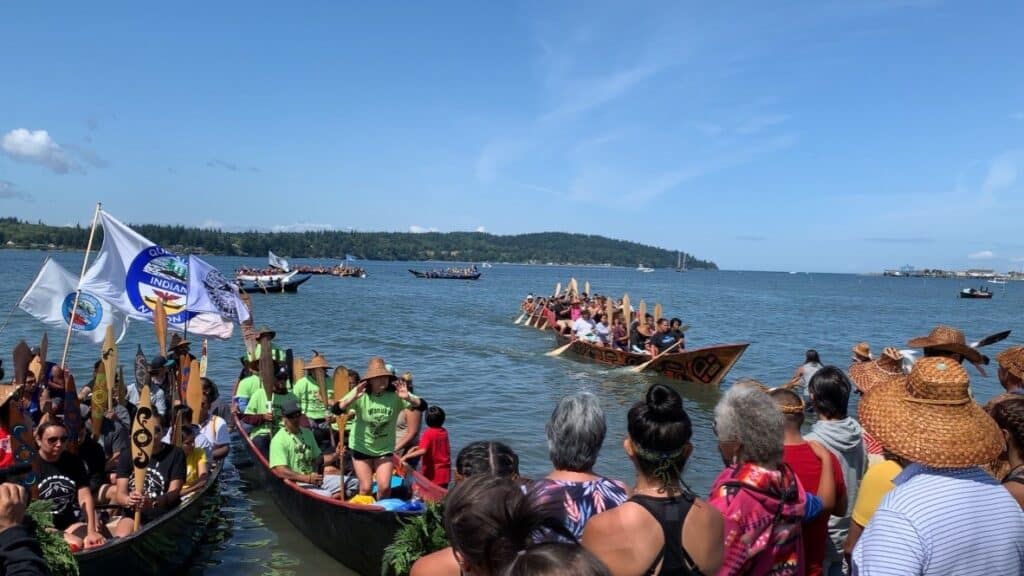
Since the Full Circle Journey, Tribal Canoe Journeys have become more frequent, with a different Tribal Nation hosting each year. According to the Squaxin Island Tribe , today an estimated 12,000 people and more than 100 canoes from up to 90 U.S. Tribes, Canadian First Nations, and New Zealand participate in the annual journeys. Many who have participated as skippers, pullers, support crew, or hosts have noted the journey’s capacity to foster healing and personal growth. “I’ve seen people where they were alcoholics go sober. Just good things have happened as a result of being a part of a Canoe Journey. I really believe that that water, and being out there in the elements, is very healing,” says Marilyn. For Angee, being a puller and skipper has taught her to have patience with others and to work through conflict.
It is common for participants to draw strength from the hardships they encounter during the journey, yet the positive experiences of teamwork and connections to Tribal traditions can be just as powerful, especially for youth. “When youth are exposed to such experiences, they are less likely to gravitate toward substance use, and it gives them the skills to make better choices into adulthood,” says Lisa Jackson, the Training and Curriculum Manager for Healing of the Canoe , a collaborative project that uses the metaphor of Canoe Journeys to engage with Tribal youth about problem-solving and substance use. “By asking youth what obstacles they could encounter on a Canoe Journey, then asking them how they would solve those problems, it paves the way for asking about obstacles in everyday life and how they might solve them.”
This year, the Muckleshoot Tribe will be hosting the first Canoe Journey since 2019, as the last few journeys have been canceled due to the pandemic. The theme for Paddle to Muckleshoot is “Honoring Our Warriors Past and Present.” The public is invited to Seattle’s Alki Point on July 30 to witness the reception of more than 100 canoes by Muckleshoot Tribal members, just as their ancestors had welcomed visitors to their shores since time immemorial.
If you would like to learn more about Tribal Canoe Journeys, we invite you to explore the following resources:
- Lushootseed Phrases to Use on Canoe Journey (Puyallup Tribe)
- Makah Protocol at Squaxin Island Hosting, 2012 (Squaxin Tribe YouTube)
- Tulalip News: Canoe Journey Articles
- Canoes – Pulling Together: A Documentary Film – by James M. Fortier (Presented by the Muckleshoot Tribe, Whatcom County Library System YouTube)
- 2018 Power Paddle to Puyallup (Native Daily Network YouTube)
- Canoe Journey – Paddle to Lummi 2019 (Children of the Setting Sun YouTube)
- Canoe Way Documentary (Cedar Media YouTube)
- Canoe Journey 2017: Catching Songs from Suquamish – Project 562 (YouTube)
- Canoe Journey: Following Traditional Protocol – Project 562 (YouTube)
- Tribal Journeys Handbook – by American Friends Service Committee
- Canoe Journey 2006 – Paddle to Muckleshoot – by American Friends Service Committee
- Tribal Canoe Journey and Science Connect in Salish Sea (Earthfix Media YouTube)
- All Nations Paddles Up – Resources for Canoe Journey Hosts and Participants
- Footage from Bella Bella 1993 Journey (YouTube)
All Stories

Journey of the Spirit
In its inaugural paddle, the UW Shell House Canoe Family joined the annual Tribal Canoe Journey, where tribal and First Nations communities reconnect and celebrate their shared heritage.
In this documentary, witness the spiritual and physical journey of the University of Washington’s first canoe family aboard the Willapa Spirit. It’s a story of reclaiming old traditions and starting new ones, and of reconnecting to a heritage that will always be an essential part of the Pacific Northwest.

Building a family through tribal canoe journey
On a hillside in Suquamish, Washington, Nicole Kuhn and her two teenage sons watched brightly colored canoes make their way toward the beach below on a sunny July afternoon.
Kuhn was searching for a canoe with a colorful red and green salmon painted on its exterior. When she spotted the canoe, she teared up. Among the paddlers — called pullers — were her two older children, Ethan and Naomi, participating in their first Tribal Canoe Journey.
Originally published November 2023
What you care about can change the world
When you support the Center for American Indian and Indigenous Studies, you strengthen American Indian, Alaska Native and other Indigenous intellectual traditions, communities and futures at the UW.
Connect with us
Uw current newsletter.

© 2024 University of Washington | Seattle, WA
Preparing for Canoe Journey
The 2023 Canoe Journey is the first since 2019. Tribal canoe families from around the northwest including Canada will paddle Salish Sea waterways. 120-130 canoes are expected to land at Alki Point starting around noon Sunday. There are multiple stops along the way and the public is welcome at all of the landings.
Monday, July 24: Lower Elwha and Samish
Tuesday, July 25: Jamestown S’Klallam and Swinomish
Wednesday, July 26: Port Townsend and Cama
Thursday, July 27: Port Gamble S’Klallam and Tulalip
Friday, July 28 and Saturday July 29: Suquamish
Sunday, July 30: Muckleshoot/Alki Point
This year’s journey, Paddle to Muckleshoot, is the first year since 2006 that the Muckleshoot people have hosted. The journey will continue for a weeklong celebration of culture and heritage after the landing on Alki at the Muckleshoot Powwow Grounds in Auburn.
For more information: https://muckleshootcanoejourney.com/
Most Read Local Stories
- Eastside's light rail wait is almost over with 'Starter Line'
- WA GOP endorses Semi Bird for governor at Trump-dominated convention VIEW
- Sudden weather change capsizes boats, leaves thousands without power
- Man killed in stabbing at Auburn's Muckleshoot casino
- Journalist, WA newspaper publisher John Brewer dies at age 76
The opinions expressed in reader comments are those of the author only and do not reflect the opinions of The Seattle Times.
Background Content
Language and culture (13-17), paddlers push off on powerful voyage to reclaim indigenous cultures across pacific northwest.

Klahoose Nation’s Tl’emtl’ems Canoe is one of hundreds joining a flotilla of Indigenous paddlers for the 2023 Tribal Journey to Muckleshoot. Photo by Michelle Robinson Listen to article
Canada’s National Observer: A flotilla of Indigenous canoes a hundred strong is converging along the Pacific Northwest as nations from Canada, the U.S. and beyond paddle hundreds of kilometres in pursuit of shared objectives and a common destination.
Paddlers from eight different canoes were hosted, fed and sheltered by the Stz’uminus First Nation near Ladysmith on Vancouver Island before launching Thursday on their first leg of the Tribal Journey, said Michelle Robinson, a member of the Klahoose Nation’s Tl’emtl’ems canoe family.
The yearly summer event sees Indigenous people from across the West Coast make the voyages of their ancestors to reclaim and revitalize their cultures and traditions, and strengthen future generations, Robinson said.
“It’s really powerful because a lot of our paddlers are on a healing journey because we have historical trauma,” she said.
Colonialism aimed to erase First Nations culture and language, and control Indigenous Peoples’ movements, Robinson said.
“Indian Affairs, the churches and the powers that be at the time told us we couldn’t even put our paddles in the water to go to the next village to visit our grandmothers,” she said. “So, it’s amazing to get in the canoe and travel together.”

Canoe families from across Alaska, B.C., Washington and Oregon are travelling along set routes, joining up at host communities along the way until critical mass is reached and the entire flotilla arrives at the Muckleshoot Indian Nation in Washington state on July 30 for a week of celebration and ceremony.
A flotilla of Indigenous canoes a hundred strong is converging along the Pacific Northwest as scores of Nations paddle hundreds of kilometres during the annual Tribal Journey. Tweet
At each stop during the journey, paddlers and the host nation conduct ceremonial protocol, where canoe families request and receive formal welcome to come ashore, Robinson said. Every landing involves a feast and cultural exchange, she added.
“Each canoe family steps on the floor. It’s just like a potlatch: they gift, they dance and share songs.”
But by the time the flotilla arrives at Muckleshoot for the grand gathering, approximately 130 canoes and hundreds of paddlers, family members, nations and support crews will gather in solidarity, she said.
Paddlers of all ages and abilities are welcome to participate in the journey even if just for a day or two, Robinson said, adding last year one canoe family had a paddler who was in her 90s. This year, Klahoose Elder Mary Harry is riding on the All Nations Paddles Up support vessels accompanying the canoes to offer paddlers support and conduct prayers, she added.
The Klahoose Tl’emtl’ems Canoe’s youngest paddler this year is 7-year-old Casey Chickite, who is embarking on her first Tribal Journey and pulling hard, Robinson said.
It’s extremely heartening to see younger generations completely centred and comfortable with canoe culture, traditional practices and Indigenous identity, she stressed.
“It’s just like breathing for Casey,” Robinson said, noting older generations still struggle to reclaim their culture because of the humiliation and abuse experienced in residential schools for being Indigenous, she said.
“You were taught to be ashamed of being native. We were taught to scrub the brown off and that our culture was bad,” she said.
“So to see us stepping over that threshold and just normalizing it again — it’s healing.”

Given the range of paddling experience in canoes, no one is expected to endanger themselves during the journey, and paddlers can sub out and rest when they wish, Robinson said. However, some days are long and the weather can be gruelling.
The 45-kilometre voyage from Songhees territory near Esquimalt on the southern tip of Vancouver Island through U.S. waters to the Lower Elwha Klallam Tribe territory on the Olympic Peninsula near Port Angeles, Wash., could be demanding.
“That crossing can be tricky because of the open water, tides and weather,” she said. “It’s quite a day for our paddlers and skippers, who are on high alert because that’s a pretty hard pull for them.”
But pulling together to overcome challenges fosters community in the canoe and on shore between nations, Robinson said. “Some days are hard or windy, but whatever comes along, that’s part of it,” she said.
“They accept it, learn to paddle together and communicate because without that, the canoe wouldn’t move forward.”
Rochelle Baker / Local Journalism Initiative / Canada’s National Observer
Return to Previous Page
Continue Reading
- Explore All Calls to Action
- More about Language and Culture (13-17)
Meet the Inuit throat singers revitalizing the tradition and engaging new audiences
‘Aunties’ teach Kahnawà:ke teens how to sew their own ribbon skirts
Anishinabemowin instructor proud, hopeful as she helps pass language to next generation in Interlake
Niagara Falls is rich with Indigenous history — a legacy these Haudenosaunee people want recognized
Passing on the art of Kanien’kehá:ka basketry, one lesson at a time
Truth & Reconcilliation
Other indigenous issues, indigenous groups, perspectives, sign up for emails.
Enter your email address to subscribe to this blog and receive notifications of new posts by email.
Type your email…
Photograph citation information

'It's good medicine': Intertribal celebration marks completion of canoe journey

Crowds filled beaches near Seattle last weekend, as tribal members stood drumming and chanting to mark the arrival of dozens of canoe families coming in to shore.
One by one, the skipper of each of the crews introduced themselves and offered a formal request for permission to come ashore.
Only after a representative of the hosting tribe acknowledged them did the paddlers set foot on land.
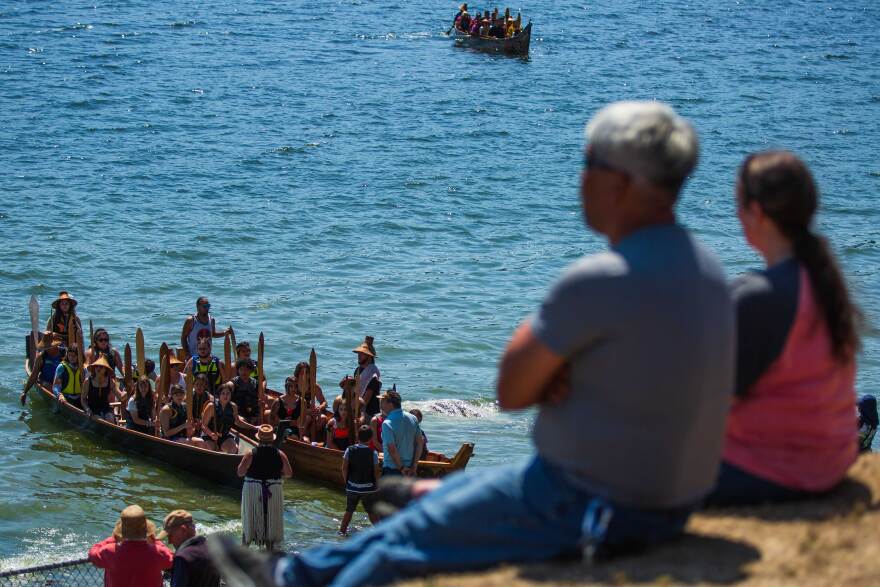
This year, Alki Beach was their final destination. Some tribal members paddled hundreds of miles to attend. Yet the trip by water, the canoe journey, is only the beginning of the celebration.
After arriving, the paddlers headed by car or van to the Muckleshoot Indian Tribe's reservation for a full week of camping out and sharing food, dances, stories and song. The round-the-clock celebration honors all the tribal cultures that come together each year for the Canoe Journey.
Canoes are at the heart of Indigenous cultures in the Pacific Northwest - they were used for transportation, fishing and hunting. And today, many say they feel connected to their ancestors through paddling and prayer.
That’s a large part of what this intertribal canoe journey is about. It’s also about sharing cultural offerings with other tribes – through formal presentations, referred to as "protocol."
Throughout the week, canoe families took the stage of the Muckleshoot Community Center in two-hour shifts. The schedule extended into the night, around the clock and continued for a week. By tradition, the first group to present is the one that traveled the farthest.

This year, that was the One People Canoe Society from Juneau, Alaska. They took a ferry to Skagway and drove through Canada to get to Bellingham, where they put their canoe in the water at the Lummi reservation, said Yarrow Vaara, who is Tlingit and one of their skippers.
“We still have camping gear that's soaking wet from our last stop, we still have sand in our shoes,” she said. “And then we're pulling out our dance gear that we've been keeping very sacredly safe and dry and clean.”

Despite that, she said everyone was excited to be at this event. After a three-year hiatus due to the pandemic, they’re “hungry for culture.”
“We've been isolated and separated and segregated in different ways, you know, from COVID, from generations of trauma and different things,” she said. “And going through COVID kind of re-ignited some of those feelings.”
Sharing is good medicine
Time spent on the water, “pulling” for long hours with your crew and often singing to stay in sync, is central to the canoe journey. Those images are the ones that tend to get the most air time. But the week of protocol afterward is equally important, said Muckleshoot Chairman Jaison Elkins. The presentations of songs, dances, cultural gifts and testimonials is available to anyone who shows up to witness it.
“And we believe that is good medicine for everybody. Because we need those teachings. We need those songs. We need the dance, and it's good medicine. It's good healing, for all of our people,” Elkins said.
He said the tribe spent two years preparing for the gathering. They set up water, camping space, restrooms and shower facilities. Elkins said over a hundred cooks were helping prepare food, including regional seafood such as salmon, crab and shrimp.
"We want to make sure they're comfortable and they're fed well while they share their songs and dances with us," he said.

“Just so everybody knows, it was against the law for us to practice our culture, not even seven generations ago,” said Freddie Lane, a Lummi community activist and former councilmember who spent hours inside the Muckleshoot Community Center during this year’s protocols, filming and livestreaming them on his Facebook page.
“It was banned by the United States and Canada,” he said of the traditional potlach that canoe journey protocols resemble. At the same time, those societies tried to erase the Indigenous cultures of the lands they settled, taking native children away from their families and sending them to boarding schools that forced them to assimilate.
He calls the week-long celebration he has helped document “the great gathering” that brings everyone together.
“Because we're still here. You know, we survived the great flood. We survived smallpox and the boarding school,” Lane said. “But we're still here and all of us can come together in a good way. And we need more of this in our communities.”

“It’s a resurgence,” said Suquamish chairman Leonard Forsman, who is also president of the Affiliated Tribes of Northwest Indians. Forsman was involved in the original Paddle to Seattle canoe journey in 1989, launched to coincide with the Washington state centennial.
He noted that before colonization by Europeans, when the culture had no written language, protocol was a key time to get stories and information from other places. Today, the annual tradition has helped revive languages and keep them alive. It has also motivated more people to learn how to make Indigenous regalia such as cedar hats and necklaces.
“And that brings a lot of pride back to our people, it incorporates and teaches us about our traditions. It's a way for people to be proud of their heritage,” he said. “And it's good for us to have that exciting time. Every year.“

Reconnecting to native culture
Sitting in the bleachers to soak up the presentations was 67-year-old John Stevenson. He’s a member of the Muckleshoot Tribe, but was adopted by a white family and grew up away from these traditions.
"Yeah, I didn't know my culture at all. And my beautiful cousins and all my relations here at Muckleshoot taught me the traditions of what it is to be in the canoe family," Stevenson said.
He said he’s deeply moved by this event – especially all the young people in their regalia, singing, dancing, and carrying their tribal cultures forward
“It’s amazing to see how native people have never gone away, no matter what happens,” he said. “And this is all of us coming together, to be able to celebrate our beautiful way of life.”


- Things to Do
- Discovery Center
- Featured Places
- Weather and Tides
- Regional Tourism Organizations
- Special Events
- History & Culture
- Environment
- Marine Life
- Ocean Conditions
- Oceanographic Moorings
- Marine Wildlife Research & Monitoring
- Seafloor Mapping
- Research Vessels
- Citizen Science
- Water Quality
- Incident Response
- Ocean Acidification
- Marine Debris Prevention
- Invasive Species Management
- Advisory Council
Twentieth Century
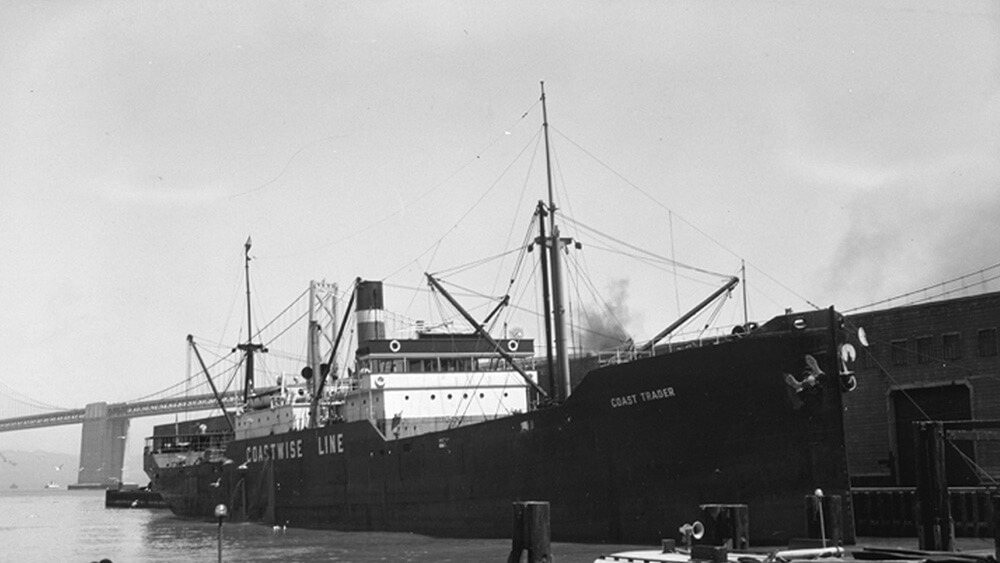
World War II Era
Japanese submarines (i-boats) on the washington coast.
The West Coast of the U.S. became an active Japanese patrol zone from December of 1941 through 1942. Japanese military strategists wanted to keep the U.S. "off balance" following the attack on Pearl Harbor; they correctly deduced that a West Coast submarine threat would tie up a considerable number of U.S. patrol vessels and aircraft that were desperately needed elsewhere.
On June 7, 1942, SS Coast Trader was sailing from Port Angeles, Washington, to San Francisco, California. About 30 miles from the Strait of Juan de Fuca, it was attacked by a Japanese submarine (I-26). Coast Trader managed to launch one lifeboat and two rafts. A nearby fishing vessel, Virginia I, towed the lifeboat to Neah Bay 30 hours after the attack. Ten hours later the Canadian corvette Edmundston (K-106) picked up the rafts carrying nine officers, 28 men, and 19 armed guards, and landed them at Port Angeles. One man died from exposure before being rescued.
On June 20, 1942, another Japanese submarine (I-25) torpedoed and shelled the freighter SS Fort Camosun off Cape Flattery. The crew abandoned ship, but before it sank, it was towed to safety in Neah Bay. The freighter was certainly saved by the crews of the rescuing ships, but also by the fact that its cargo of plywood provided critical buoyancy. No lives were lost. The SS Fort Camosun reached safety in Neah Bay. It was subsequently towed to Esquimalt, British Columbia, then to Victoria, then to Seattle for repairs. It returned to help in the war effort and survived another torpedo in the Gulf of Aden. U.S. destroyers sank the I-25 in 1943.
Cold War Era
1966 soviet fishing fleet.
In 1966, a Soviet fishing fleet appeared off the Washington and Oregon coast. At that time, the U.S. territorial sea only extended to three nautical miles offshore. An account from Bob Hitz, a now-retired marine biologist, describes this remarkable sight during a research trip just off the coast of Washington in 1966:
"Everywhere else there were ships, a huge fleet of Russian ships and as the sun rose, the red hammer and sickle on the stacks seemed to glow from the reflection."
This event angered WWII veterans, Washington Democratic U.S. Senator Warren Magnuson and Alaska Republican Senator Ted Stevens. Cold War politics dominated the worldview of Magnuson, a naval veteran during World War II, who bristled at the sight of Soviet catcher-processors just off the picturesque coastline of Washington and Oregon. Thousands of foreign boats plundered haddock and other fish stocks off New England as well, and Japanese trawlers clustered year-round in Alaska waters. But it was the industrial-scale Soviet fleet off the Pacific Northwest that especially bothered Magnuson.
Magnuson and Stevens agreed it was time for the United States to establish a 200-mile exclusive fisheries zone off the coastlines, and in 1976 an ocean fishery management law, today known as the Magnuson-Stevens Fishery Conservation and Management Act, was passed.
1969 Amchitka Nuclear Testing
The Aleutian island of Amchitka was selected by the U.S. Atomic Energy Commission to be the site for underground detonations of nuclear weapons. Three such tests were carried out: Long Shot, an 80-kiloton blast in 1965; Milrow, a 1-megaton blast in 1969; and Cannikin in 1971—at 5 megatons, the largest underground test ever conducted by the United States. These tests were highly controversial—environmental groups feared that the Cannikin explosion, in particular, would cause severe earthquakes and tsunamis. Amchitka is no longer used for nuclear testing, though it is still monitored for the leakage of radioactive materials. As part of mitigation from the nuclear tests, 59 sea otters were captured and translocated to multiple locations including the Olympic Coast.
United States Versus Washington
In the 1970s, Native American tribes in the state of Washington sought to have greater access to their treaty resources and uphold their treaty rights in federal court. The outcome of this arduous legal path re-established these treaties as the supreme law of the land and culminated in the seminal case of United States v. Washington, written by Judge George Boldt and often referred to as the “Boldt decision”. In arriving at the decision upholding the treaty rights, Judge Boldt traced the history of the salmon fishing tribes of the state of Washington to treaty-time signing periods. Judge Boldt’s decision recounts:
“From the earliest known times, up to and beyond the time of the Stevens’ treaties, the Indians comprising each of the treating tribes and bands were primarily a fishing, hunting, and gathering people dependent almost entirely upon the natural animal and vegetative resources of the region for their subsistence and culture. . . . The treaty-secured rights to resort to the usual and accustomed places to fish were a part of larger rights possessed by the treating Indians, upon the exercise of which there was not a shadow of impediment, and which were not much less necessary to their existence than the atmosphere they breathed. The treaty was not a grant of rights to the treating Indians, but a grant of rights from them, and a reservation of those not granted.” U.S. v. Washington 384 F. Supp. 406-407.
The treaty right to fish is constrained only by the requirement to ensure fishery resources are preserved and maintained. Additionally, Executive Order 13175 requires the sanctuary to consult with the tribes, in a timely manner, if a proposed regulation might adversely impact them.
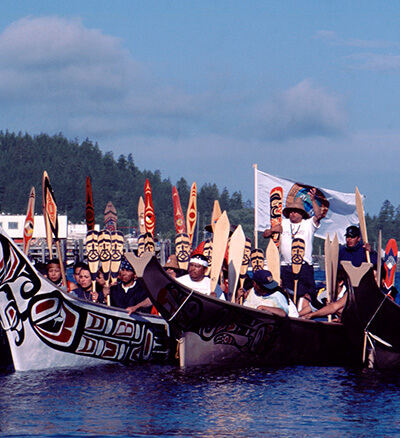
Tribal Journeys
Pacific Northwest tribes were renowned for their seamanship and skill in making canoes. These sea-worthy vessels, crafted from a single red cedar log, were a major part of their culture. Over time as tribal people adopted newer technologies, the building and use of the traditional canoes had almost disappeared. The 1989 “Paddle to Seattle” was the beginning of a revival of traditional tribal maritime heritage. Since that first tribal canoe journey, it has become an almost annual event involving tribes from the United States and Canada. Sometimes, Indigenous people from further away will participate with their traditional craft. The first 1989 event started from La Push on the Quileute Reservation. The Coastal Treaty Tribes in Washington have hosted four of the journeys, 1997 Paddle to La Push, 2002 Paddle to Quinault, 2010 Paddle to Makah, and 2013 Paddle to Quinault.
Makah Whale Hunt
The Makah Tribe has always had a special connection to the ocean, and whaling plays a central part of their identity and culture. During treaty negotiations, Governor Isaac Stevens noted that, “the great father knows what whalers you are—how you go far to sea to take whale.” As a result of the Treaty of Neah Bay, the Makah secured their continued right to whale. While this was a recognized treaty right, commercial whaling decimated whale populations, leading the Makah to give up whaling in 1928. During the sanctuary designation process, the Makah made it clear to NOAA that when the gray whale was delisted from the endangered species list, they would seek to resume exercising their treaty right.
Additional Resources
- Makah Tribe: The Makah Whaling Tradition
- NOAA Fisheries: Makah Tribal Whale Hunt
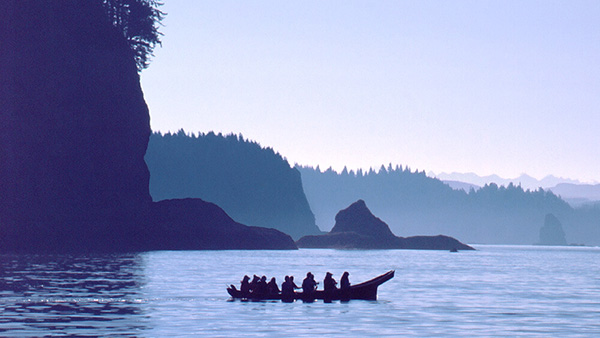
Original Peoples
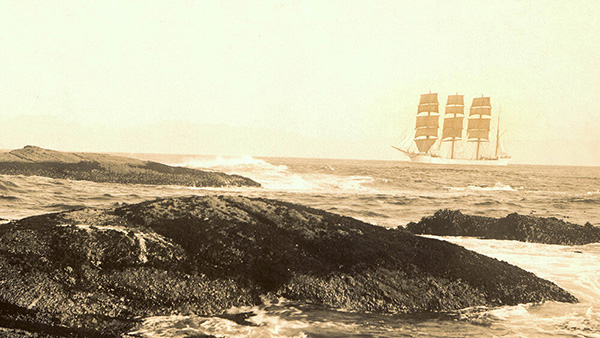
European Colonial Period
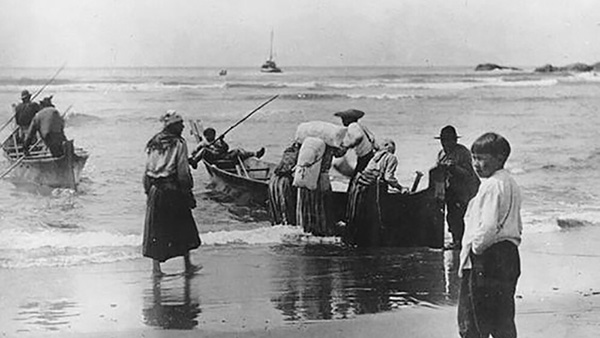
American Period
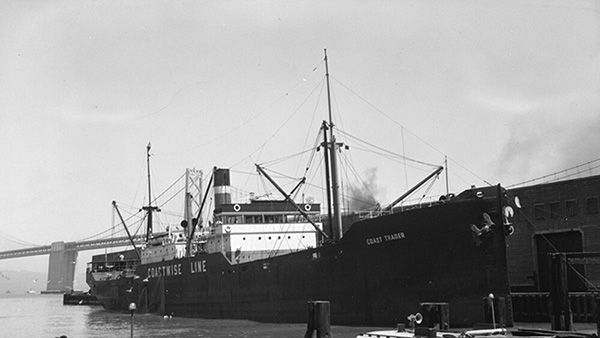

All Nations
Training Program
US/Canada Delivery Schedule
Registration
Preparing for the Canoes Hosting Handbook Menu Planning & Shopping Tips
Beach CleanUp, Fundraising Pre-Journey Workout, Paddling Techniques, Safety Practices

All Nations 2024 Canoe Schedule

All Nations is pleased to once again be supported by Captain Randy Sonnier and the crew of the Pearl.
Awaken the Canoes Tsawout-Cowichan-Shell Beach-Snuneymuxw
Parkland Pull Qualicum -Nanoose-Snuneymuxw
Loving Waters Qualicum -Nanoose-Snuneymuxw
Young Warriors Snuneymuxw-Shell Beach - Snuneymuxw
Strong Women of the Water Lummi-Waldron-Orcas-Lummi
Routes subject to change for more information or to join, please contact all nations. please note: restricted participation on loving waters and young warrier pulls.
Puyallup Youth Canoe Pull Summer 2024 Contact: Connie McCloud for details Canoe meeting in March
Important Announcement:
There is currently no host Nation for Tribal Journeys 2024

All Nations Strong Women of the Water Canoe
In 2018, Klahoose Elder Billy Barnes bestowed the name Strong Women of the Water to a group of pullers arriving in Port Townsend , Washington, enroute to Puyallup's Tribal Journeys.
The women carry this sacred name with great pride and ea ch year since, welcome others to join the Strong Women of the Water (and the men who support them) pull.
Now, thanks to the generosity of All Nations supporters, we have placed our order for a new 36" Pacific Dance Canoe The Strong Women of the Water Canoe will arrive in time for Awaken the Canoes this spring.
Emote - Hu Huy ch-qu. Thank you to all those who made this amazing purchase possible.
Remembering our Friend MIKE EDWARDS
The All Nations Canoe Family was saddened to learn of the passing of our dear friend. Mike was a long-time figure in c anoe journeys and a strong supporter of ou r organization.
He will be missed.
Our hearts and prayers go out to his family, friends, and community.

Strong Women of the Water Closes the All Nations 2023 Canoe Season
An amazing and diverse delegation of pullers joined with All Nations for the final pull of the 2023 season. For the most part, weather cooperated and the group was treated to a few beautiful sunrises during the four day event. Two humpback whales put on an unforgettable show, breaching out of the water in an incredibly display of power.
As always, we thank our organizers, cooks, funders, and the crew of the Pearl who towed the canoe hundreds of miles from Washington State to Fort Rupert. Emote as well to Jonnica Ro yal who skipped and to Steven Recalma for the use of Singing Coho.
STRONG WOMEN PRE-DEPARTURE PRESENTATION
Muckleshoot protocol: the competition song.
Sister Nations Klahoose, Tl'amin and Homalco brought their signature song to the floor during protocol. Always a favorite among the crowd, you be the judge...who has bragging rights this year, the Men or the Women?
_JPG.jpg)
Parkla nd Pu ll
Fantastic Success June 9-11
Vancouver Island
All Nations was pleased to host the Parkland Team aboard the Singing Coho , skippered by Steven Recalma. Rain and winds did not deter the group although poor conditions did pull the Coho off the water for the final day of the pull.
Thank you to Captain Sonnier and the crew of the Pearl, and our All Nations family who made the weekend so special for our guests.
Upcoming Events
Puyallup youth canoe pull contact: connie mccloud for details, emerging leaders training: information session, canoe journey tips, all nations canoes are supported by captain randy sonnier and the crew of the pearl. for more information on their services, please visit sparrowcanoesupport.com do you have what it takes to be a good skipper this short article by ron snyder is the perfect way to check five water safety strategies. great reminders before we head out on the water .

sparrowcanoesupport.com
Empower our communities.

JUUstice Washington
A Unitarian Universalist State Action Network
Tribal Canoe Journeys
2020 paddle to snuneymuxw, nanaimo, bc – cancelled.
Snuneymuxw cancels Tribal Journeys Paddle to Snuneymuxw due to COVID-19
Due to the Covid-19 pandemic and the emergency public health crisis that is impacting communities, Snuneymuxw First Nation has cancelled hosting Tribal Journeys on July 27 – August 1, 2020 in Snuneymuxw territory. Protecting the health and wellbeing of the public is the greatest priority while following the health orders issued by the Public Health Officer.
Chief Mike Wyse said on behalf of Snuneymuxw First Nation that “Covid-19 poses a serious threat to the health and well-being of paddlers, Canoe Families and First Nations across the Pacific North West. Given the enormous health and safety risk to participants of Tribal Journeys 2020, we have decided that it is in the best interest of everyone that Snuneymuxw cancel hosting Tribal Journeys this year. There will be many questions given we are in unprecedented times. We ask for the understanding and support of those who are assisting to plan, organize and fund Tribal Journeys 2020. Your partnership with Snuneymuxw is appreciated and I know we will work through this together. If there is an opportunity for Snuneymuxw to resume as hosts for Tribal Journeys sometime in the future, we are honoured to do that.”
Tribal Journeys is a longstanding tradition that unifies Indigenous Nations and is a celebration of Indigenous peoples. Chief Wyse says “it is a way for our culture and tradition to be shared with the world. While large gatherings is our custom, the health risk due to COVID-19 is substantial and we cannot bring thousands of people together for a number of days with the presence of the pandemic. The long-term impacts of COVID-19 is unknown and we must err on the side of caution to protect everyone.”
Chief Wyse assures all that “there will come a time when we will celebrate Indigenous culture and resilience with friends, relatives, Canoe Families, Elders, children and youth. Until then, we wish you all health and safety and send our solidarity as you care for each other during this crisis.”
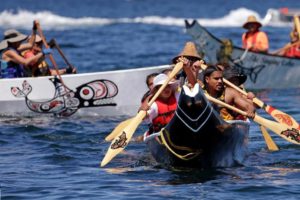
The Canoe Journey is an annual event in which Pacific Northwest Tribes travel the ancestral highways of their cultures. Tribes from Oregon, Washington, Alaska and British Columbia have participated and hosted landings. The landings are events that occur along the canoe journey route The Canoe Journey began in 1989, part of the 100th anniversary of Washington Statehood in which the state and indigenous governments signed the Centennial Accord, recognizing indigenous sovereignty. Canoe Journeys have organized up and down the whole Pacific Northwest Coast and being hosted by many different Northwest Native communities.
In the past several years, UU congregations throughout the region have been finding ways to work with and support Pacific Northwest Tribes in the U.S. and Canada in these journeys.
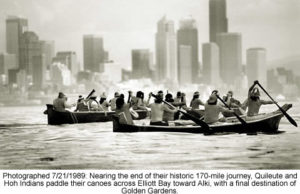
Recent Canoe Journeys can be followed on the Tribal Canoe Journeys Facebook page .
1989: Paddle to Seattle, WA Emmett Oliver’s 1989 Paddle to Seattle 1993: Paddle to Bella Bella, BC Qatuwas 1994: Youth Paddle (Olympia, WA, with the 2nd Cedar Tree Conference)
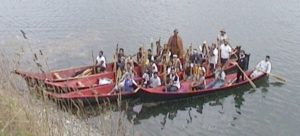
1995: Full Circle Youth Paddle, in Puget Sound, Washington 1996: Full Circle Youth Paddle, in Puget Sound, Washington 1997: Paddle to LaPush, WA 1998: Paddle to Puyallup, WA 1999: Paddle to Ahousaht, BC 2000: Paddle to Songhees, BC
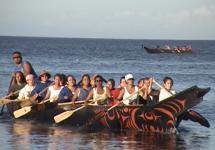
2001: Paddle to Squamish, BC 2002: Paddle to Quinault, Taholah, WA 2003: Paddle to Tulalip, WA 2004: Paddle to Chemainus, BC 2005: Paddle to Elwha, Port Angeles, WA 2006: Paddle to Muckleshoot, Auburn, WA 2007: Paddle to Lummi, WA
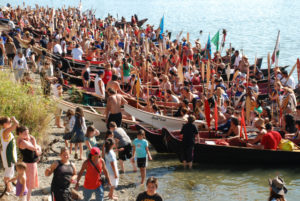
2008: Paddle to Cowichan, Cowichan Bay, BC 2009: Paddle to Suquamish, WA 2010: Paddle to Makah, Neah Bay, WA 2011: Paddle to Swinomish, La Conner, WA 2012: Paddle to Squaxin Island, Kamilche, WA 2013: Paddle to Quinault at Taholah, WA

2014: Paddle to Bella Bella, Qatuwas Festival, at Bella Bella, BC on Campbell Island, BC 2015: Various locations in the Salish Sea, BC and WA 2016: Paddle to Nisqually, Olympia, WA 2017: We Wai Kai Nation and Wei Wai Kum Nation, Campbell River Spit, BC. 2018: Paddle to Puyallup, Tacoma, WA 2019: Paddle to Lummi, Bellingham, WA
2020 Paddle to Snuneymuxw, Nanaimo, BC!!
Lummi members to sue seaquarium to bring captive orca home event, july 27th, 11:00 am, lummi nation reservation, northwest tribes land at alki during annual canoe journey.
By Brian Contreras, Seattle Times July 18, 2019 “The canoes are coming!” a young girl cried from the crowd of onlookers. “They’re right there!” The 20-odd canoes approached Alki Beach just before noon Thursday as part of the “Paddle to Lummi” — or Sqweshenet Tse Schelangen (“honoring our way of life”) — a journey through the Salish Sea toward the Lummi Nation, this year’s host. During the annual Tribal Canoe Journey, tribes and nations from throughout the Pacific Northwest join up with one another on the way toward Lummi, starting from different points but picking up new canoes along the way. Read more here .
PHOTO GALLERY: 2019 Canoe Journey lands at Jamestown Beach
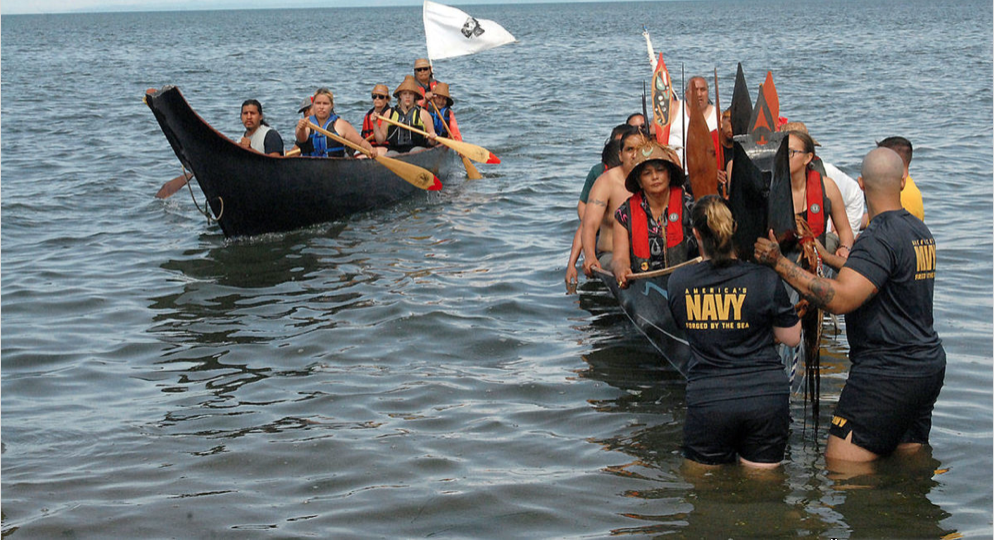
Paddle to Lummi Community Volunteer Orientation and sign-up info
This will be the only community volunteer orientation before the landing..
- The history of Tribal Journey
- Ways to support the event through your contributions and volunteer efforts
- What is involved in hosting 10,000 people a day and serving over 11,000 meals a day
- What to expect about noon landing of tribal canoes, June 24, and start of cultural protocol after dinner that night
- What cultural protocols are followed by host nation and the visiting Tribal Nations?
- Where to park and get from one venue to another

BRING A FOOD ITEM/S TO THE EVENT FOR LANDING CANOE FAMILY'S GIFT BOXES
Further things to do now to support 2019 tribal canoe journey, support lummi nations hosting of 2019 tribal canoe journey.
- Raise $300,000 towards the $1.1 million cost
- Help make handmade gifts as part of the handmade 10,000 that will be gifted
- Help create an official acknowledgement of the Original Peoples of These Lands and Waters (July 13, Maritime Heritage Park)
- Recruit volunteers for the work involved to bring funds, gifts, and services from the entire county, and afar to support this amazing event!
The Moscow Trials and the "Great Terror" of 1937-1938: What the Evidence Shows
Grover Furr July 31 2010
[To be added at the end of Part One of "Stalin and the Struggle for Democratic Reform" ]
Since my two-part essay "Stalin and the Struggle for Democratic Reform" was written in 2004-5, a great deal more evidence has been published concerning the Opposition, the Moscow Trials of 1936, 1937, and 1938, the Military Purges or "Tukhachevsky Affair", and the subsequent "Ezhovshchina", often called "the Great Terror" after the title of the extremely dishonest book by Robert Conquest first published in 1968.
The newly-available evidence confirms the following conclusions:
* The defendants at the Moscow Trials of August 1936, January 1937, and March 1938, were guilty of at least those crimes to which they confessed. A "bloc of Rights and Trotskyites" did indeed exist. It planned to assassinate Stalin, Kaganovich, Molotov, and others in a coup d’�tat , what they called a "palace coup" ( dvortsovyi perevorot ). The bloc did assassinate Kirov.
* Both Rights and Trotskyites were conspiring with the Germans and Japanese, as were the Military conspirators. If the "palace coup" did not work they hoped to come to power by showing loyalty to Germany or Japan in the event of an invasion.
* Trotsky too was directly conspiring with the Germans and Japanese, as were a number of his supporters.
* Nikolai Ezhov, head of the NKVD from 1936 to late 1938, was also conspiring with the Germans.
We now have much more evidence about the role of NKVD chief Nikolai Ezhov than we had in 2005. Ezhov, head of the NKVD (People’s Commissar for Internal Affairs), had his own conspiracy against the Soviet government and Party leadership. Ezhov had also been recruited by German intelligence.
Like the Rights and Trotskyites, Ezhov and his top NKVD men were counting on an invasion by Germany, Japan, or other major capitalist country. They tortured a great many innocent people into confessing to capital crimes so they would be shot. They executed a great many more on falsified grounds or no grounds at all.
Ezhov hoped that this mass murder of innocent people would turn large parts of the Soviet population against the government. That would create the basis for internal rebellions against the Soviet government when Germany or Japan attacked.
Ezhov lied to Stalin, the Party and government leaders about all this. The truly horrific mass executions of 1937-1938 of almost 680,000 people were in large part unjustifiable executions of innocent people carried out deliberately by Ezhov and his top men in order to sow discontent among the Soviet population.
Although Ezhov executed a very large number of innocent people, it is clear from the evidence now available that there were also real conspiracies. The Russian government continues to keep all but a tiny amount of the investigative materials top-secret. We can’t know for sure exactly the dimensions of the real conspiracies without that evidence. Therefore, we don’t know how many of these 680,000 people were actual conspirators and how many were innocent victims.
As I wrote in 2005, Stalin and the Party leadership began to suspect as early as October 1937 that some of the repression was done illegally. From early in 1938, when Pavel Postyshev was sharply criticized, then removed from the Central Committee, then expelled from the Party, tried and executed for mass unjustified repression, these suspicions grew.
When Lavrentii Beria was appointed as Ezhov’s second-in-command Ezhov and his men understood that Stalin and the Party leadership no longer trusted them. They made one last plot to assassinate Stalin at the November 7, 1938 celebration of the 21 st anniversary of the Bolshevik Revolution. But Ezhov’s men were arrested in time.
Ezhov was persuaded to resign. An intensive investigation was begun and a huge number of NKVD abuses were uncovered. A great many cases of those tried or punished under Ezhov were reviewed. Over 100,000 people were released from prison and camps. Many NKVD men were arrested, confessed to torturing innocent people, tried and executed. Many more NKVD men were sentenced to prison or dismissed.
Under Beria the number of executions in 1938 and 1940 dropped to less than 1% of the number under Ezhov in 1937 and 1938, and many of those executed were NKVD men, including Ezhov himself, who were found guilty of massive unjustified repression and executions of innocent people.
Some of the most dramatic evidence published since 2005 are confessions of Ezhov and Mikhail Frinovsky, Ezhov’s second-in-command. I have put some of these on the Internet in both the original Russian and in English translation. We also have a great many more confessions and interrogations, mostly partial, of Ezhov, in which he makes many more confessions. These were published in 2007 in a semi-official account by Aleksei Pavliukov.
Anticommunist Scholars Hide the Truth
All "mainstream" – that is, anticommunist – and Trotskyist researchers falsely claim that there were no conspiracies. According to them, all the Moscow Trial defendants, all the military defendants, and all those tried and sentenced for espionage, conspiracy, sabotage, and other crimes, were innocent victims. Some claim that Stalin had planned to kill all these people because they might constitute a "Fifth Column" if the USSR were attacked. Other anticommunists prefer the explanation that Stalin just tried to terrorize the population into obedience.
This is an ideological, anticommunist stance masquerading as an historical conclusion. It is not based upon the historical evidence and is inconsistent with that evidence. Anticommunist historians ignore the primary source evidence available. They even ignore evidence in collections of documents that they themselves cite in their own works.
Why do the anticommunist "scholars", both in Russia and the West, ignore all this evidence? Why do they continue to promote the false notions that no conspiracies existed and that Stalin, not Ezhov, decided to execute hundreds of thousands of innocent people? The only possible explanation is that they do this for ideological reasons alone. The truth, as established by an examination of the primary source evidence, would make Stalin and the Bolsheviks "look good" to most people.
Collectivization of Agriculture Saved The World from Nazis and Japanese…
We have an example of this ideological bias in the way anticommunist scholars and writers treat the Bolshevik collectivization of agriculture. Anticommunists have long attacked it as immoral and unjustified. Yet collectivization provided the capital for the crash industrialization of the USSR. And only industrialization made a modern Red army possible.
Without a technologically-advanced modern army the Nazis would have conquered the USSR. Then, with the resources and manpower of the USSR and the rest of Europe behind them, the Nazis could have invaded the British Isles. Nazi armies would have been a far more formidable foe against all Allied powers. Meanwhile the Japanese, strengthened by the petroleum of the Soviet Far East, would have been a far more formidable enemy for the USA in the Pacific war.
Millions more Slavs and Jews – "Untermenschen" to the Nazis – and millions more Europeans and American soldiers – would have been killed. That this did not occur can be attributed, in large part, to the Soviet collectivization of agriculture. This is an obvious conclusion. There was simply no other way than by collectivizing agriculture that the USSR could have industrialized, and thus stood up to the Nazis and Japanese.
The only alternative was the one promoted by the Right and Trotskyite conspirators: to make peace with the Germans and Japanese, even if that meant granting them huge trade and territorial concessions. That would have greatly strengthened the Axis powers in their war against the U.K. and the USA.
For purely ideological reasons anticommunists cannot admit that collectivization made it possible for the Axis to be defeated.
… And So Did The Defeat of the Conspirators in 1936-1938
Whether they were able to seize political power through a "palace coup", or whether they would have to rely on a German and/or Japanese attack as they only way they might be able to overthrow the Stalin government, the Opposition conspirators were planning some kind of alliance with the Axis.
In fact they would have had no choice, as they realized themselves. A USSR weakened by internal revolt, with or without an invasion from abroad, would have had to make trade, territorial, and ideological concessions to its major potential adversaries simply in order to avoid invasion and inevitable conquest.
At a minimum, a USSR led by some combination of conspirators would have made treaties with Germany and Japan that would have provided the Axis powers with huge natural resources, possibly with manufactured goods as well. The military conspirators were contemplating going much farther than mere trade with the Axis. They were contemplating an outright military alliance with Germany. That would have meant millions more soldiers to fight alongside the German Wehrmacht.
Therefore, in foiling the machinations of the Rights, Trotsky and his supporters, and the Military conspirators, Stalin saved Europe from Naziism – again!
No doubt this is why anticommunist "scholars" insist, in the face of all the evidence, that there were no conspiracies in the USSR and no collaboration with the Germans and Japanese. Once again they refuse to admit these truths on purely ideological grounds because doing so would seem to justify Stalin’s actions.
Bukharin, Not Stalin, To Blame for the Massive Repressions
One interesting aspect of this is that Nikolai Bukharin, leading name among the Rightists and one of its leaders, knew about the "Ezhovshchina" as it was happening, and praised it in a letter to Stalin that he wrote from prison.
It gets even better. Bukharin knew that Ezhov was a member of the Rightist conspiracy, as he himself was. No doubt that is why he welcomed Ezhov's appointment as head of the NKVD -- a view recorded by his widow in her memoirs.
In his first confession, in his now-famous letter to Stalin of December 10, 1937, and at his trial in March 1938 Bukharin claimed he had completely "disarmed" and had told everything he knew. But now we can prove that this was a lie. Bukharin knew that Ezhov was a leading member of the Rightist conspiracy -- but did not inform on him. According to Mikhail Frinovsky, Ezhov's right-hand man, Ezhov probably promised to see that he would not be executed if he did not mention his own, Ezhov's, participation (see Frinovsky's confession of April 11, 1939 ).
If Bukharin had told the truth -- if he had, in fact, informed on Ezhov -- Ezhov's mass murders could have been stopped in their tracks. The lives of hundreds of thousands of innocent people could have been saved.
But Bukharin remained true to his fellow conspirators. He went to execution -- an execution he swore he deserved "ten times over" * -- without revealing Ezhov's participation in the conspiracy.
This point cannot be stressed too much: the blood of the hundreds of thousands of innocent persons slaughtered by Ezhov and his men during 1937-1938, are on Bukharin's hands.
Objectivity and Evidence
I agree with historian Geoffrey Roberts when he says:
In the last 15 years or so an enormous amount of new material on Stalin … has become available from Russian archives. I should make clear that as a historian I have a strong orientation to telling the truth about the past, no matter how uncomfortable or unpalatable the conclusions may be. … I don’t think there is a dilemma: you just tell the truth as you see it. ("Stalin’s Wars", Frontpagemag.com February 12, 2007. At http://hnn.us/roundup/entries/35305.html )
The conclusions I have reached about the "Ezhovshchina" will be unacceptable to ideologically-motivated people. I have not reached these conclusions out of any desire to "apologize" for the policies of Stalin or the Soviet government. I believe these to be the only objective conclusions possible based on the available evidence.
I make no claim that the Soviet leadership was free from error. Stalin’s vision of a socialism leading to communism was obviously faulty in that it did not come to pass. During Stalin’s time, as during the short period of Lenin’s leadership, the Soviets made a great many errors. Error is, of course, inevitable in all human endeavor. And since the Bolsheviks were the first communists to conquer and hold state power, they were in unknown waters. It was inevitable, therefore, that they would make a great many mistakes – and they did.
However, any objective study of the evidence and the historical record shows that there was simply no alternative to forced collectivization and industrialization – except defeat at the hands of some combination of capitalist powers. Likewise, the fact that the Right, Trotskyite, and Military conspiracies really did exist but were snuffed out by the Soviet leadership, which managed to out-maneuver Ezhov and foil his conspiracy as well, proves that once again the USSR – "Stalin" – saved Europe from Naziism and all the Allies from an immense number of additional casualties at the hands of the Axis powers.
* Bukharin's two appeals for clemency, both dated March 13, 1938, were reprinted in Izvestiia September 2, 1992, p. 3. They were rejected, and Bukharin was executed on March 15, 1938. I have put them online in English here.
Additional Bibliography
Ezhov’s interrogations: I have translated all of Ezhov’s interrogations available to me as of July 2010 and put them online here:
http://msuweb.montclair.edu/~furrg/research/ezhovinterrogs.html (Russian original: http://msuweb.montclair.edu/~furrg/research/ezhovpokazaniia.html )
Lubianka. Stalin I NKVD – NKGB – GUKR "SMERSH". 1939 – mart 1946 . Moscow, 2006.
- Frinovsky confession of April 11, 1939, pp. 33-50. http://msuweb.montclair.edu/~furrg/research/frinovskyeng.html (Russian original here: http://msuweb.montclair.edu/~furrg/research/frinovskyru.html )
- Ezhov confession of April 26, 1939, pp. 52-72. http://msuweb.montclair.edu/~furrg/research/ezhov042639eng.html (Russian original: http://msuweb.montclair.edu/~furrg/research/ezhovru.html )
Petrov, Nikita, Mark Jansen. "Stalinskii pitomets" – Nikolai Ezhov . Moscow: ROSSPEN, 2008, pp. 367-379.
- Ezhov confession of August 4, 1939. http://msuweb.montclair.edu/~furrg/research/ezhov080439eng.html (Russian original: http://msuweb.montclair.edu/~furrg/research/ezhov080439ru.html )
Furr, Grover and Vladimir L. Bobrov, "Bukharin's Last Plea: Yet Another Anti-Stalin Falsification." http://msuweb.montclair.edu/~furrg/research/bukhlastplea.html - translation of Russian original published in Aktual’naia Istoriia for February 2009 at http://actualhistory.ru/bukharin_last_plea
Furr, Grover and Vladimir L. Bobrov, "Nikolai Bukharin's First Statement of Confession in the Lubianka" in English translation, Cultural Logic 2007 - http://clogic.eserver.org/2007/Furr_Bobrov.pdf
Furr, Grover and Vladimir L. Bobrov, "Pervye priznatel'nye pokazaniia N.I. Bukharina na Lubianke." Klio No. 1 (2007). http://msuweb.montclair.edu/~furrg/research/furrnbobrov_klio0107.pdf
Furr, Grover and Vladimir L. Bobrov, eds. "Lichnye pokazaniia N. Bukharina." Klio (St. Petersburg), No. 1 (2007). http://msuweb.montclair.edu/~furrg/research/furrnbobrov_klio0107.pdf
Furr, Grover. "Evidence of Leon Trotsky's Collaboration with Germany and Japan." In Cultural Logic for 2009. http://clogic.eserver.org/2009/Furr.pdf
Holmstr�m, Sven-Eric. "New Evidence Concerning the 'Hotel Bristol' Question in the First Moscow Trial of 1936". Cultural Logic 2008. At http://clogic.eserver.org/2008/Holmstrom.pdf
Furr, Grover.Khrushchev Lied: The Evidence That Every "Revelation" of Stalin's (and Beria's) Crimes in Nikita Khrushchev's Infamous "Secret Speech" to the 20th Party Congress of the Communist Party of the Soviet Union on February 25, 1956, is Provably False. Kettering, OH: Erythros Press & Media LLC, 2011. At Amazon.com ; at Erythros Press & Media : at Abebooks.com ; at Abebooks.co.uk (United Kingdom)
Furr (‘Ferr’), Grover Antistalinskaia podlost’ ("Anti-Stalin Villanies"). Moscow: Algoritm, 2007. Home page: http://www.algoritm-kniga.ru/ferr-g.-antistalinskaya-podlost.html Brief summary in this interview: "The Sixty-One Untruths of Nikita Khrushchev" (Interview with Grover Furr). http://msuweb.montclair.edu/~furrg/research/litrossiainterv0608_eng.html (original here: http://www.litrossia.ru/article.php?article=3003 )
Pavliukov, Aleksei. Ezhov. Moscow: Zakharov, 2007.
Alexander Radishchev, Journey from St. Petersburg to Moscow. 1790
Alexander Radishchev (1749-1802) came from a moderately wealthy noble family with landholdings in Saratov Province. He was educated in the Corps of Pages in St. Petersburg and went on to study law and philosophy at the University of Leipzig in Germany. On his return to Russia in 1771, Radishchev pursued a intermittent career in state service rising eventually to the post of Chief of the St. Petersburg Customs House. In 1790, Radishchev published Journey from St. Petersburg to Moscow, a passionate tirade against the evils of serfdom and the corruption of Russian life. Radishchev's journey marks the first open condemnation of serfdom in Russian public life, and his overwrought emotional portrayals, drawing heavily on the style and motifs of pre-romantic sentimentalism, quickly drew the attention of Russian readers and the wrath of Catherine the Great. Alarmed by the radicalism of the French Revolution, Catherine saw in Radishchev's audacity a threat to the state and pronounced him "a rebel worse than Pugachev." Radishchev was arrest, tried and condemned to death, a sentence which Catherine commuted to 10 years exile in Siberia. Under Paul I, Radishchev was released from exile and his full rights as a nobleman were restored in 1801. He committed suicide in 1802.
Twice every week all of the Russian Empire is informed that N. N. or B. B. is unable or unwilling to pay what he has borrowed, taken or what is demanded from him. The borrowed money has been gambled away, traveled away, spent away, eaten away, drunk away, given away or has perished in fire and water. Or N. N. or B. B. has in some other way gone into debt or incurred an obligation. Any case will do for the announcement which reads: At ten o clock this morning, on order of the county court or city magistrate, the real estate of retired captain T... consisting of house no. X, in such and such a district and six male and female souls, will be sold at auction. The sale will take place at said house. Interested parties may view the property in advance.
Everyone is interested in a bargain. The day and hour of the sale has arrived. Buyers are assembling from all around. In the hall where the sale is to take place, the condemned are standing motionless. An old man of 75 years, leaning on a elmwood cane, is anxious to find out into whose hands his fate will pass, who will close his eyes. He served with the Master’s father in the Crimean campaign under Field Marshal Munnich. At the battle of Frankfurt he carried his wounded master off the field of battle on his shoulders. Returning home, he became the tutor for his young master. In childhood, he saved the boy from drowning, jumping into the river into which he had fallen while crossing on a ferry, and putting his life at risk, pulled him out. In youth he bailed him out of prison where he had been confined for his debts incurred while serving as a junior officer. An old women, 80 years of age, the old man’s wife, was the wet nurse for the mother of the young master: she was the young man’s nanny and had been the housekeeper up until the very moment when she was brought out for this auction. In all the years of her service she never wasted anything of the master’s, never thought of her own profit in any way, never lied, and if she ever gave occasion for annoyance it was only on account of her simple hearted scruples. A woman 40 years of age, a widow, was the wet nurse for the young master. And even now she still feels a certain tenderness toward him. Her blood flows in his veins. She is his second mother: he owes his life to her even more than to his natural mother. The latter had conceived him in a light-hearted moment, and had taken no part in his infancy. His nurses brought him up. They part with him as if with a son. A young woman, 18 year of age, her daughter and the granddaughter of the old couple. Wild beast, monster, reprobate! Look at her, look at her crimson cheeks, at the tears pouring from her enchanting eyes. Was it not you who, failing to entrap her innocence through flattery and enticement or to shake her steadfastness with threat, finally resorted to deceit. Having married her to your companion in treachery, your took his place and partook of the pleasure, which she had disdained to share with you. She found out about your deceit. Her bridegroom touched no more her bed, and your, deprived of the object of your desire, turned to force. Four scoundrels, executors of your will, holding her arms and legs--- No! Let us go no further. On her brow is sorrow, in her eyes despair. She is holding the infant, the sorrowful fruit of your deceit or violence, and the living image of his lascivious father. Having given birth to him, she began to forget his father’s savagery, and her heart began to feel tenderness toward the baby. She is afraid that he will fall into the hands of another like his father. The infant...your son, barbarian, your blood. Or do you think that there is not obligation when there was no church ceremony? Do you think that the blessing given at your order to the hired preacher of the word of God has confirmed their union? Do you think that forced marriage in God’s church can be called matrimony? The Almighty despises force, and delights in the wishes of the heart; they alone are uncorrupted. O, how many acts of fornication and seduction are committed in the name of the father of joys and the comforter of sorrows in the presence of his witnesses, unworthy of their office! A youth of twenty five, her wedded husband, companion and confidant of his master, who has now repented of his services. In his pocket is a knife. He grasps it tightly; it is not hard to guess his thoughts. Fruitless zeal! You will go to another. The hand of your master, hanging constantly above the head of the slave will bend your neck to any service. Hunger, chill, torment and heat – all of this will stand against you. Your mind is alien to noble thoughts. You do not know how to die. You will bend and will become a slave in spirit as we as law. And if you take it in to your mind to resist, you will die an agonizing death in chains. There is no justice over you both. If your tormentor does not wish to punish you himself he will become your accused. He will turn you over to the city justice. Justice! Where the accused has almost no power to defend himself! Let us pass over the other unfortunates brought out for sale.
Barely had the dreaded hammer let out its hollow thud when the four unfortunates learned their fate – tears, sobs and moans pierced the ears of the entire assembly. Even the hardest were moved. Petrified hearts! Almost fruitless sympathy? O Quakers! If we had your hearts we would have made a collection, bought these unfortunates and given them their freedom. Having lived many years in each other’s embrace, these unfortunates because of this abominable auction will feel the anguish of parting. But if the law or, better to say, barbarian custom, for this is not written in the law, allows such contempt for humanity, who has the right to sell this infant? He is illegitimate: the law liberates him. Stop, I will denounce this; I will save him. But if only the others could be saved along with him. O fortune! Why have you doled out to me such a miserly share. It is only now that I begin to feel the passion for wealth. My heart is so troubled that I jump up from amid the assembly and giving the last pennies from my wallet to the unfortunates, I run out. On the stairway, I met a friend, a foreigner.
"What has happened to you? You are weeping!."
"Go back" I said to him, "do not be a witness to this shameful spectacle. O, once you cursed the barbaric custom of selling of black slaves in far off colonies of your fatherland; go back," I repeated, "do not be a witness to our darkness lest you must reveal our shame to your countrymen in talking to them of our customs." "I can not believe it," my friend said to me. "It is impossible that in a place were all are allow to think and believe as they wish, such a shameful custom exists." "Do not be astonished." I said to him, "the establishment of freedom of belief offends only priests and monks, and even they are more interested in acquiring sheep for themselves rather than for Christ’s flock, but freedom for rural inhabitants would offend, as they say, the right of property. And all those who might be fighters for freedom are all great landowners, and freedom is not to be expected from their council but the from the heavy weight of enslavement itself.
Source: A. N. Radishchev, Puteshestvie is Peterburga v Moskvu, Volnost' . (St. Petersburg: Nauka, 1992) pp. 92-94.
Translated by Nathaniel Knight
For an English translation of the full text see Aleksandr Nikolaevich Radishchev, A Journey from St. Petersburg to Moscow (Cambridge, Mass: Harvard UP, 1958).

Enjoy fast, free delivery, exclusive deals, and award-winning movies & TV shows with Prime Try Prime and start saving today with fast, free delivery
Amazon Prime includes:
Fast, FREE Delivery is available to Prime members. To join, select "Try Amazon Prime and start saving today with Fast, FREE Delivery" below the Add to Cart button.
- Cardmembers earn 5% Back at Amazon.com with a Prime Credit Card.
- Unlimited Free Two-Day Delivery
- Streaming of thousands of movies and TV shows with limited ads on Prime Video.
- A Kindle book to borrow for free each month - with no due dates
- Listen to over 2 million songs and hundreds of playlists
- Unlimited photo storage with anywhere access
Important: Your credit card will NOT be charged when you start your free trial or if you cancel during the trial period. If you're happy with Amazon Prime, do nothing. At the end of the free trial, your membership will automatically upgrade to a monthly membership.
Buy new: $65.00
Return this item for free.
Free returns are available for the shipping address you chose. You can return the item for any reason in new and unused condition: no shipping charges
- Go to your orders and start the return
- Select the return method

Download the free Kindle app and start reading Kindle books instantly on your smartphone, tablet, or computer - no Kindle device required .
Read instantly on your browser with Kindle for Web.
Using your mobile phone camera - scan the code below and download the Kindle app.

Image Unavailable

- To view this video download Flash Player
A Journey from St. Petersburg to Moscow Hardcover – February 5, 1958
Purchase options and add-ons.
- Part of series Russian Library
- Print length 294 pages
- Language English
- Publisher Harvard University Press
- Publication date February 5, 1958
- Dimensions 6.14 x 0.69 x 9.21 inches
- ISBN-10 0674435184
- ISBN-13 978-0674435186
- See all details

Similar items that may deliver to you quickly

Product details
- Publisher : Harvard University Press; Reprint 2014 edition (February 5, 1958)
- Language : English
- Hardcover : 294 pages
- ISBN-10 : 0674435184
- ISBN-13 : 978-0674435186
- Item Weight : 1.34 pounds
- Dimensions : 6.14 x 0.69 x 9.21 inches
- #16,532 in Russian History (Books)
Customer reviews
Customer Reviews, including Product Star Ratings help customers to learn more about the product and decide whether it is the right product for them.
To calculate the overall star rating and percentage breakdown by star, we don’t use a simple average. Instead, our system considers things like how recent a review is and if the reviewer bought the item on Amazon. It also analyzed reviews to verify trustworthiness.
- Sort reviews by Top reviews Most recent Top reviews
Top review from the United States
There was a problem filtering reviews right now. please try again later..
- Amazon Newsletter
- About Amazon
- Accessibility
- Sustainability
- Press Center
- Investor Relations
- Amazon Devices
- Amazon Science
- Sell on Amazon
- Sell apps on Amazon
- Supply to Amazon
- Protect & Build Your Brand
- Become an Affiliate
- Become a Delivery Driver
- Start a Package Delivery Business
- Advertise Your Products
- Self-Publish with Us
- Become an Amazon Hub Partner
- › See More Ways to Make Money
- Amazon Visa
- Amazon Store Card
- Amazon Secured Card
- Amazon Business Card
- Shop with Points
- Credit Card Marketplace
- Reload Your Balance
- Amazon Currency Converter
- Your Account
- Your Orders
- Shipping Rates & Policies
- Amazon Prime
- Returns & Replacements
- Manage Your Content and Devices
- Recalls and Product Safety Alerts
- Conditions of Use
- Privacy Notice
- Consumer Health Data Privacy Disclosure
- Your Ads Privacy Choices

- Travel Guides
First Timer’s Travel Guide to Moscow & Saint Petersburg
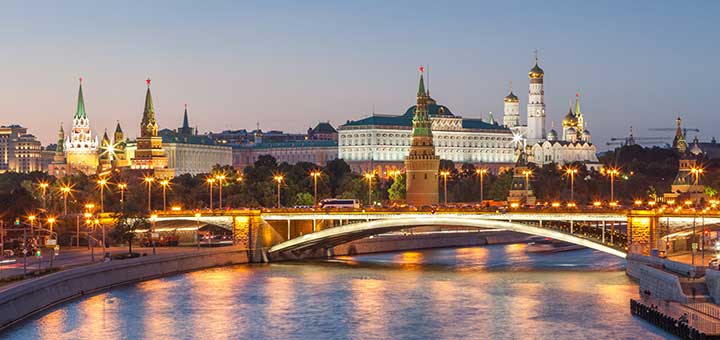
Russia is this vast, diverse, and magnificent land that many international travellers dream of visiting. The capital city Moscow and the second largest city in the country St Petersburg are, in particular, one of the most magical and interesting cities in the world you can visit all year-round. That is why today we decided to focus yours and our attention to both cities. Learn how to explore them properly if you are a first-time visitor. How to ensure that you make the most of your visit. What to expect, etc.
The Kremlin, Moscow
Despite the fact that even a month or two will not be enough to explore Moscow or St Petersburg to the fullest and enjoy everything these amazing cities have to offer, not many of us have the luck to spend such a long time abroad. We would provide you with some recommendations and ideas you can totally make happen within a 4-day itinerary in Moscow and a 4-day itinerary in St Petersburg.
St Petersburg
In addition, please note that the majority of the international and continental flights are to the capital city Moscow that is a home to the biggest and most popular airport in the country. So Moscow will be the starting point of your over a week-long journey to Russia. Let’s discuss some of the basics you should know and prepare for!
The first thing you have to do when planning to visit Russia is applying for a visa. There are only a few countries in the world that are to require a visa when visiting the country. In the majority of the cases, you should have one in order to visit the country. Be prepared for your visa application by making sure you own and can provide a proof of arrival and departure dates, and an invitation letter from either a tour provider or an accommodation booked.
Make sure to check out the website of your country’s government for additional requirements and papers needed. The easiest way to get an invitation letter from an accommodation is by booking a major hotel chain. They are more used to dealing with international visitors and will assist and support you throughout the process, providing you with everything you need for entering the country. Please keep in mind that the application process can take up to a few weeks and you have to send your original passport away, so make sure you don’t need it during this time.
However, there is one way to visit St Petersburg for three days visa-free. This happens if you arrive by ferry or cruise ship when you will be allowed to arrive and stay in the city for 72 hours without applying for a visa. This is the only way and a great option to visit one of the most magnificent and impressive cities in Russia without going through the whole visa application process that can be pretty overwhelming, indeed.
Well, Russian language is not the most popular in the world, despite the fact it is spoken by a big number of people, who are citizens not only of the country but also of the ex-USSR. Chances are, you are not familiar with the language and with the Cyrillic alphabet used in the country, where you will find that the majority of the signs around the cities are in Cyrillic, which can make it harder for you to find your way around, but also a great bunch of the names of many international brands and companies. In addition, once you get to Russia you will find out that English is definitely not widely-spoken by the general population, even in big cities such as Moscow and St Petersburg, where most of the people, no matter their age, will speak little to no English.
However, don’t be afraid that you will get lost or in trouble. Let Google Translate, hand gestures, and a little common sense make all the hard work and you will be ok. Keep in mind that having an Internet connection on your phone all the time will be very helpful for finding your way around. In addition, many restaurants in the main tourist areas in both cities have an English menu you can ask for, while the same applies to the maps and brochures of the major tourist attractions.
Getting Around
Both Moscow and St Petersburg have an awful traffic, which means that taxis can cost you a lot. Buses and cars can take a long time when traffic is at its full potential and in order to save yourself some time and coins. We highly recommend you using the metro/underground systems in both cities. Moscow’s metro system is simply amazing. It has a huge network of interconnecting lines that will help you get around and across the city very efficiently.
Make sure to grab a map of the Moscow’s metro, which will make it very easy to navigate, plus the stations are announced in English. In addition, using the metro is incredibly cheap and it will get you anywhere in the city for less than $1. Moscow’s metro is also known for some of the most beautiful and spectacular metro stations in the world that are definitely worth visiting as amazing tourist attractions of their own.
The metro is St Petersburg isn’t nearly as extensive as the Moscow’s one and the stations are more spread out. In this case, you can take advantage of the Uber service in the city and explore St Petersburg by ordering an Uber driver that will cost you significantly cheaper than a taxi. Thanks to the big number of drivers available, you will be able to find a free car very quickly. However, considering the fact that St Petersburg is more touristy and most of the main sights are located in what is called the Golden Triangle, you can easily explore the main tourist attractions by foot. There are also sightseeing buses and canal transports that will take you all along and around the main sights in St Petersburg.
The Russian currency is Russian ruble and you can expect to spend a lot of it because both Moscow and St Petersburg are pretty expensive cities with a higher standard and cost of living. Knowing that both cities are generally pretty expensive will help you plan that fact into your budget and consider some way to spend money if you are not travelling with a limitless budget. For example, make sure to choose a hotel that is in the outskirts of the city and in a short walking distance from a metro station. This way you can save a huge amount of money compared to a hotel in the city centre and you can also save on travel time. If you are student do not forget to take your valid student ID with you since some attractions and museums are offering a student discount.
Tickets and Attractions
When it comes to tickets for shows, museums, and attractions, the best way is to buy them beforehand. This way you can save time and not wait in hours-long lines, you can even benefit from an online purchase discount, and most importantly – you can make sure that your place and visit is reserved since many attractions in Russia sell a limited amount of tickets per day. There are some places that are very popular and tickets can sell out weeks in advance. An online purchase will help you figure out what and when you can visit, and you can plan your tour better and more effectively.
The weather in Moscow and St Petersburg can be pretty unpredictable all year-round. Because of that make sure to pack a variety of clothes for all seasons, dress in layers, and don’t take the weather forecast for the day as a final promise. Make sure to always take an umbrella or a raincoat with you. For women, bringing a scarf can be very useful for a practical reason, but also because some churches and cathedrals in Russia expect you to cover your hair with a scarf.
If you are a foodie, you will be happy to know that Russia has its very own and unique cuisine and we highly recommend you trying out some of the most popular dishes in the country including the Russian dumplings pierogi, the infamous Russian salads such as Olivie, Mimoza, and Seliodka pod shuba, etc. However, if you are not willing to try out the local cuisine, there are many international restaurants and familiar fast food chains in both cities Moscow and St Petersburg.
Things to Do and Places to See
Both Moscow and St Petersburg are cities that offer a lot to be seen, explored, experienced, and enjoyed. Some of the most important, stunning, and exciting sights in Moscow: the Red Square, where you can visit the St. Basil’s Cathedral and the GUM Department Store. The Kremlin that contains the Great Bell Tower. The Tsar Bell, Tsar Cannon, several cathedrals, gardens, and the Armory Chamber. Arbat Street is the most touristic street in Moscow with a lot of places to eat, plenty of shops to buy, and all the souvenirs you can ever imagine and want to take home with you.
St. Basil’s Cathedral
The metro stations, despite the fact that they are one of the busiest in the world, are definitely very clean and beautifully constructed and ornamented. Izmaylovsky Flea Market is just a few metro stations away from the centre. It is a great place to get to know the Russian culture and everyday life while shopping for some more authentic and interesting souvenirs. Sparrow Hill is one of the highest spots in Moscow and offers some great views of the modern city, plus it is the location of the Lomonosov Moscow State University.
Saint Petersburg is often referred to as one of the most beautiful and stunning cities not only in Russia but in the whole world. It has plenty of unique sights and magnificent things to see in the city. If your time is limited you should make sure to cover at least the highlights. The Church of the Savior on Spilled Blood, since its exterior and interior, are equally breath-taking.
The Church of the Savior on Spilled Blood
Hop on a canal cruise to explore the city from a different perspective. Visit Kazan Cathedral and St. Isaac’s Cathedral, where you can go inside and also climb the stairs to the top and enjoy some stunning views of the city. The Palace Square, which is home to the Winter Palace, which was the lavish residence of the Russian monarchs and is nowadays a part of the Hermitage Museum.
Kazan Cathedral
Of course, visiting Saint Petersburg without visiting the Hermitage Museum is like going to Rome and not seeing the Pope. The Hermitage is one of the largest and most spectacular museums in the world and a day is not enough to explore each and every one of its nooks and corners. When in the city, you can also visit the Peter and Paul Fortress, the Peterhof Palace.
Despite the fact that media loves to sensationalise the negative stories in Russia and the fact that the country is often portrayed as a pretty unsafe place by the western media, the chances of you getting into a trouble, feel threatened, or in a danger are as minimal as possible. However, keep in mind that some things are rather recommended not to do, for example taking a picture of any government, military or security building. Despite not forbidden, you better use your camera for capturing some more exciting moments. In addition, always bring a photocopy of your passport and visa with you, since police can demand you to legitimize yourself anytime.
Tags: Russia Travel Guides
Leave a Reply Cancel reply
Your email address will not be published.
Current ye@r *
Leave this field empty
- Next story 6 Must-Visit Places in Wales
- Previous story Travelling the World with Electrical Devices
You may also like...

Guest Post: Facts That Make Dubai a Sought-after Destination
April 9, 2018
by advancedholidays · Published April 9, 2018 · Last modified September 5, 2018
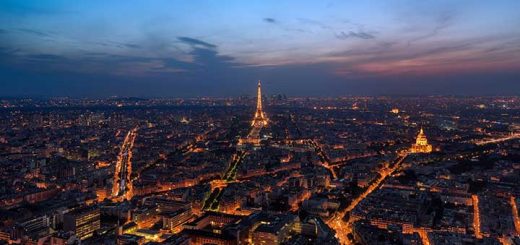
Paris – The Most Romantic City in The World
July 5, 2017
by advancedholidays · Published July 5, 2017 · Last modified July 27, 2018
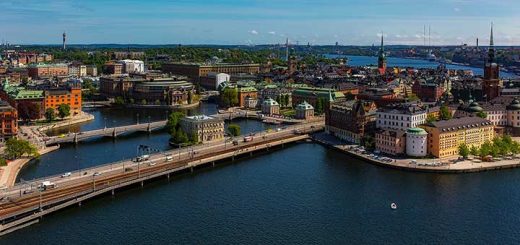
Guest Post: 8 Things to Do In Stockholm – Explore Stockholm Beauty
May 10, 2018
by advancedholidays · Published May 10, 2018 · Last modified July 27, 2018
- Travel Deals
- Travel Destinations
- Travel Tips
- World Cuisine
As salmon are released into the Klamath River, tribal leaders see a ‘symbol of hope’

- Show more sharing options
- Copy Link URL Copied!
While work crews continued dismantling dams on the Klamath River, leaders of four tribes gathered on a riverbank last week to watch and offer prayers as a valve on a tanker truck was opened. From a chute, a stream of water filled with wriggling fish poured into the river.
Over two days, workers from the California Department of Fish and Wildlife released 16 truckloads of juvenile salmon that were raised in a newly built hatchery. About 500,000 salmon swam downriver, and tribal leaders said they expect these fish will flourish when they migrate back upstream in a few years to spawn in a free-flowing river.
“They’re a symbol of hope,” said Phillip Williams, a member of the Yurok Tribal Council.
Williams said as he watched the fish disappear into the river that he thought about how he and many other tribal members will be able to catch some of those salmon when they return in three or four years.
“They’re going to feed families,” Williams said. “So that was really, really emotional.”

Aggressive and impactful reporting on climate change, the environment, health and science.
The young fish were raised at the Fall Creek Fish Hatchery and included about 90,000 coho salmon, a threatened species, as well as more than 400,000 fall-run Chinook salmon.
The last time state workers released Chinook salmon in February, they let loose more than 800,000 fish in a tributary upstream of Iron Gate Dam, which is slated to be removed, and the fish were later found dead in the river . Biologists determined the salmon died as they passed through a tunnel beneath the dam.
To prevent that from happening again, state officials selected another location just downstream of Iron Gate Dam.
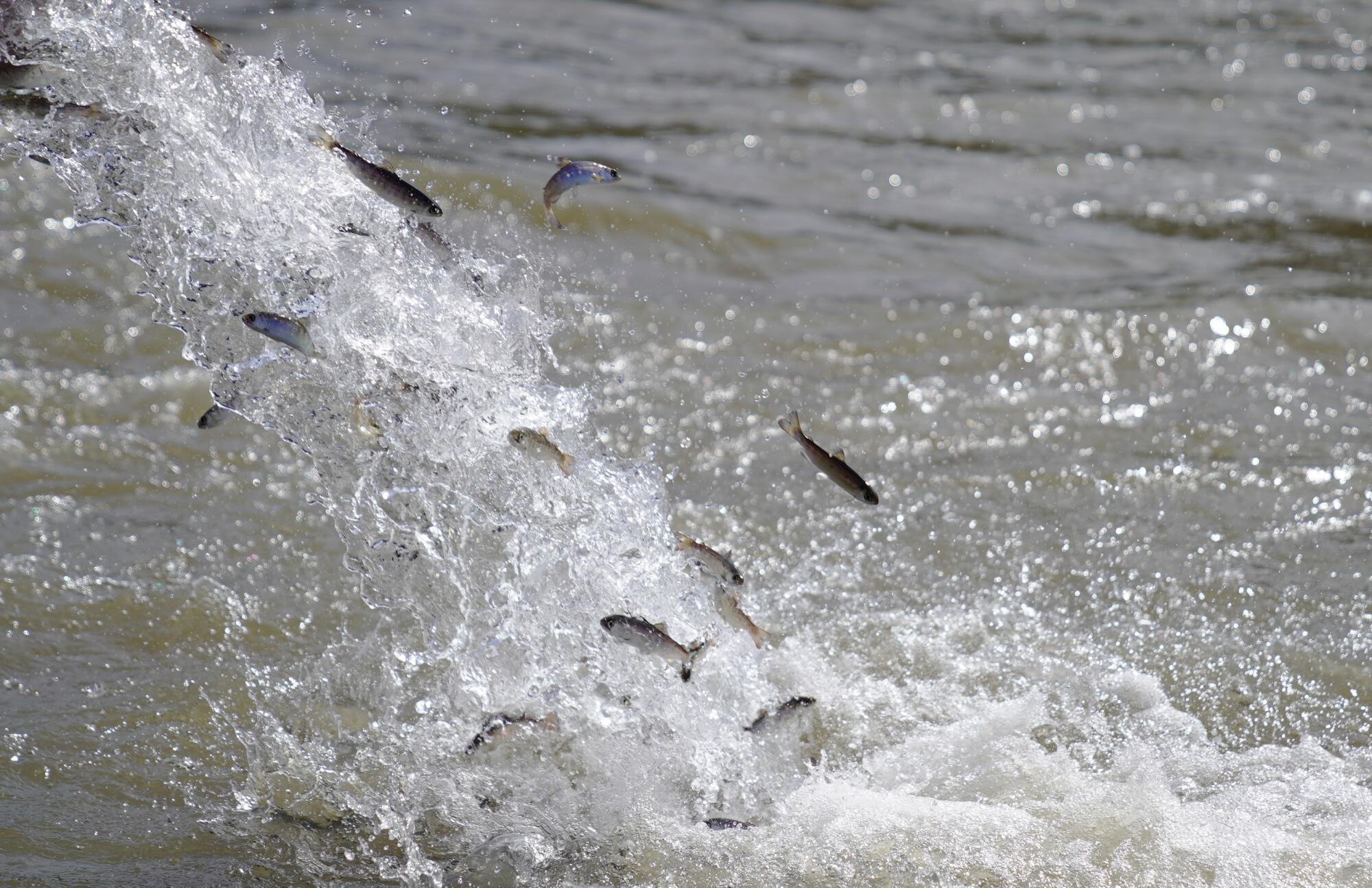
They also ran a test ahead of time, placing groups of young salmon into the river in 2-foot-long plastic cylinders, called “live cars,” to ensure the water quality was right for the fish to survive their journey to the ocean. That two-day test confirmed the fish stayed healthy in the river.
This time, state officials said the release was a complete success.
Karuk Tribe Vice Chair Kenneth Brink sang as the stream of fish-filled water gushed into the river within sight of the dam. Others offered prayers.
“This river is our church, and that salmon is the cross on that church,” Brink said.
“It’s going to be a very, very, very healing experience to be able to see the salmon come back, to have our religion come back, and to be able to live as Karuk people,” he said in a video recorded after the release. “It’s like a new beginning.”

Climate & Environment
The Klamath River’s dams are being removed. Inside the effort to restore a scarred watershed
Reservoirs have been drained as the nation’s largest dam removal effort advances on the Klamath River, and an effort to restore the watershed is taking root.
March 24, 2024
Leaders of the Shasta Indian Nation and the Quartz Valley Indian Tribe also watched as the salmon headed downstream.
It was the first major release of coho salmon into the Klamath since the removal of four dams began last year.
Water is now passing through tunnels in three remaining dams near the California-Oregon border, and reservoirs that once submerged valleys have been drained .
Work crews have been blasting and tearing into one concrete dam. Sometime this fall, the dams are scheduled to be completely removed, reestablishing a free-flowing stretch of river for the first time in more than a century. Once the dams are gone, salmon will be able to swim upstream and spawn along about 400 miles of the Klamath and its tributaries.
Some of the fish that were released are expected to return in a few years as adults to Fall Creek Fish Hatchery, a $35 million facility that was built as part of the dam removal agreements between California, Oregon and the utility PacifiCorp, which operated the dams.
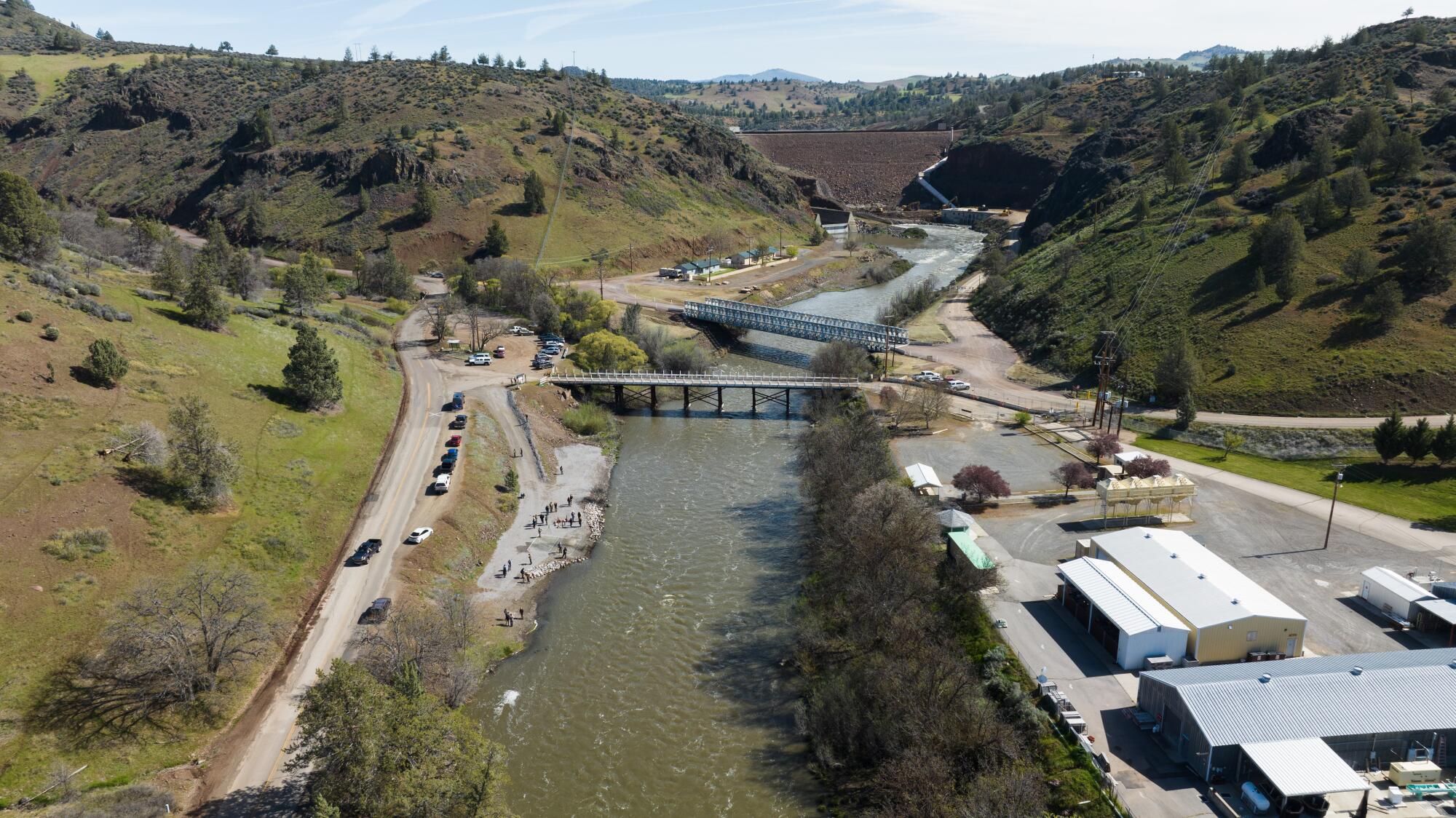
Some of the fish are also expected to be among the first to spawn in the wild along stretches of the river that were previously sealed off by the dams.
“These fish are going to be the fish that help the population that comes back,” said Charlton “Chuck” Bonham, director of the California Department of Fish and Wildlife.
The draining of the reservoirs this winter sent muddy, sediment-laden water flowing downstream. The abrupt worsening of water quality caused a drop in the amount of oxygen in the water, killing fish including nonnative perch, bluegill and bass that had been introduced in the reservoirs.
The state’s tests have shown the river conditions have improved and are now suitable for salmon to thrive, Bonham said. “The releases over the last couple of days show the river is good and only going to get better.”

The largest dam removal in history stirs hopes of restoring California tribes’ way of life
Native activists fought for years to build support for taking down dams on the Klamath River in Northern California. Now, they hope removing the dams will help save their salmon.
Oct. 5, 2023
Later in the spring, state hatchery managers plan to release nearly 2 million Chinook salmon smolts into the river.
Scientists expect that the $500-million dam removal project, the largest in history, will help boost salmon populations in the coming years.
Salmon populations have suffered declines in recent years, and fishing for Chinook salmon was banned along the California coast this year for a second year in a row.
Leaders of the Yurok and Karuk tribes plan to decide soon how much, if any, fishing they will allow this year.
More to Read

Column: The salmon industry faces extinction — not because of drought, but politics and government policies
April 18, 2024

Coastal salmon fishing banned for a second year amid steep population declines
April 11, 2024

As fish deaths increase at pumps, critics urge California agencies to improve protections
April 8, 2024

Ian James is a reporter who focuses on water in California and the West. Before joining the Los Angeles Times in 2021, he was an environment reporter at the Arizona Republic and the Desert Sun. He previously worked for the Associated Press as a correspondent in the Caribbean and as bureau chief in Venezuela. He is originally from California.
More From the Los Angeles Times

California sets nation-leading limit for carcinogenic chromium-6 in drinking water

Avian flu outbreak raises a disturbing question: Is our food system built on poop?

‘Scammed on the worst day of my life’: Pet owners say cremation service took their money, ghosted them
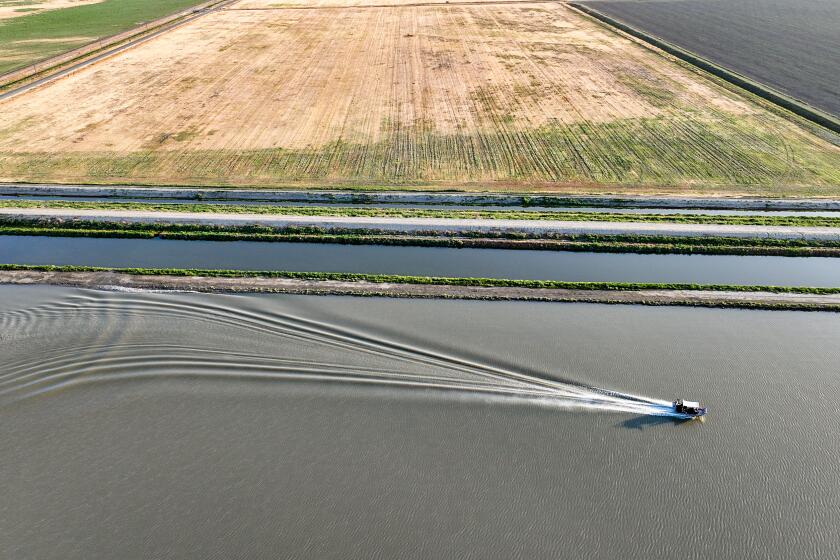
California farming area placed on probation over declining groundwater and sinking land
April 17, 2024
Watch CBS News
"RuPaul's Drag Race" 16 finalist Sapphira Cristal opens up about journey, love for Philadelphia
By Josh Sanders
Updated on: April 18, 2024 / 8:50 PM EDT / CBS Philadelphia
PHILADELPHIA (CBS) - "RuPaul's Drag Race" has been a cultural phenomenon challenging how society understands gender. After 16 seasons, not only does the 27-time Emmy Award-winning show have its first Philadelphia-based queen, but Sapphira Cristál is also in the finale to become "America's Next Drag Superstar."
"The full fantasy? Probably about an hour, maybe two hours," Cristál said.
From fantasy to reality, Cristál is a self-proclaimed jewel of Philadelphia, the city she's called home for the past 10 years.
"Something about Philly, the energy is right here," Cristál said. "It really makes you feel like you are part of something."

CBS News Philadelphia joined Cristál getting into drag for a watch party at the Theatre of the Living Arts on South Street .
Cristál is the first queen to represent Philadelphia on the main stage of RuPaul's Drag Race since the show began in 2009.
"I auditioned for 'Drag Race' 11 times," Cristál said.
This season, she's one of the three finalists competing for the crown and America's Next Drag Superstar title.
Along the way, Cristál introduces a national audience to her classically trained voice as a bona fide opera singer with a six-octave range.
"I am very in the moment when I'm on stage," Cristál said. "I am paying attention to what I am performing. Especially when lip-syncing to somebody else's words, but can you tell a story while you do it? Can you bring them on a journey? That is my goal. Let's go on this journey together."

On this journey, she's felt the love of Philadelphia.
"A mother last night said, 'My three sons are all Eagles fans and right now, they are Sapphira fans. They are all about you,'" Cristál said. "Straight men are going to watch 'Drag Race' because there is some Philly representation because they are so Philly."
But that support isn't the reality for many queens across the country with the political lightning rod of anti-drag bills attacking drag performers and seeking to ban the art form.
Last month, a drag storytime event at a Lancaster, Pennsylvania, library was called off after multiple bomb threats in the area, police said.
"If we are going to call ourselves the home of the free and the land of the brave," Cristál said, "then you should be brave enough to be able to let somebody do drag, be brave enough to let someone enjoy whatever art form they want to enjoy."
It is that freedom Cristál said she does see in families that come to her performances, like the ones who embrace her in the meet-and-greets behind the stage.

"Everyone needs to be celebrated," Cristál said.
Crown or no crown, she said she will continue to use her platform to spread love, just like the city that embraced her 10 years ago.
"It's a ride-or-die city," Cristál said, "so no matter what happens, I know Philly has got my back, and I can't say that for everyone else."
Philadelphia honors Cristál ahead of finale
Philadelphia City Council honored Cristál Thursday.
Councilmembers Nicolas O'Rourke and Rue Landau introduced the resolution.
"We are here to celebrate a certified star," O'Rourke said. "A hopeful RuPaul's Drag Race champion and already the winner in and of the hearts of Philadelphians."
"Sapphira Cristál's success is a testament to the power of being absolutely true to oneself, and I am proud to recognize her achievement during our council session," Landau said.
Cristál is proud of the city, too.
"When I moved [to Philadelphia], it was the queerest place I've ever lived in my life," Cristál said. "It allowed me to be free; it is easy to be you when you just feel comfortable."
That comfort for the LGBTQ+ community isn't felt everywhere, with hundreds of anti-LGBTQ bills introduced this year alone, according to the ACLU.
"We as drag artists are representations of freedom," Cristál said. "We get to be whoever we want to be whenever we want to be. Drag is such a wide tapestry of freedom."
Crown or no crown, Cristál said she will keep using her platform to spread love. "We will find out what happens tomorrow, but I know in my heart of hearts that I'm a winner, baby."
ITS SAPPHURSDAY!! pic.twitter.com/YmlPaoA98V — Councilmember Rue Landau (@RuePhilaCouncil) April 18, 2024
When is the RuPaul's Drag Race season 16 finale?
The finale for RuPaul's Drag Race Season 16 is Friday, April 19.
Where to watch RuPaul's Drag Race season 16 finale
The finale airs at 8 p.m. ET on MTV. People without cable can stream it online through Philo , DIRECTV Stream and FuboTV .
Who are the finalists for RePaul's Drag Race season 16?
Philadelphia's Sapphira Cristál will compete for the crown as "America's Next Drag Superstar" with Nymphia Wind and Plane Jane.
- Pennsylvania
- Philadelphia
- RuPaul's Drag Race
Josh Sanders is a journalist shaped by life-changing events. He joined the CBS News Philadelphia family in August 2023 as a reporter and multi-skilled journalist.
Featured Local Savings
More from cbs news.

Philadelphia's Sapphira Cristál is the runner up of season 16 of RuPaul's Drag Race

Communities across Philly region to plant trees, preserve planet on Earth Day

2 taken to hospital after crash in Center City, Philadelphia police say

Philadelphia community members rally to combat gun violence after teen's death
- Search Please fill out this field.
- Manage Your Subscription
- Give a Gift Subscription
- Newsletters
- Sweepstakes
- Entertainment
The NHL's First Official Woman 'Cup Keeper' Talks Journey to Her Job at the Hockey Hall of Fame (Exclusive)
Miragh Bitove began working at the Hockey Hall of Fame as an intern before working her way up to handling the Stanley Cup
:max_bytes(150000):strip_icc():format(webp)/SeanNeumann-PEOPLE-718cf3b51a4648c98dd8bbd62d70796e.jpg)
Nirva Milord
Miragh Bitove has history with the game of hockey.
The Toronto native, who first began working at the Hockey Hall of Fame in 2003 as an intern, remembers her childhood as that of a “rink rat,” who rarely spent a day away from her local ice arena. Whether she was watching her brothers play, or passing a puck herself, Bitove’s whole life seemed to revolve around the sport of hockey – a game her father absorbs like water as a fan, and one that employed his uncle before him as a player for the Toronto Maple Leafs .
But now Bitove is adding her own history to the game.
Last summer, the longtime Hockey Hall of Fame archivist and mother of three became the first woman to officially be named a “Cup Keeper” during the trophy’s summer Champions Tour, when players and coaches from the winning team each get a day with the Stanley Cup .
“Honestly, I don't think that part has necessarily settled in yet,” Bitove tells PEOPLE during a recent interview from her office at the Hockey Hall of Fame, surrounded by gloves, sticks, and other gear she’s actively archiving in the game’s history. “Most days when I'm in the office, I'm writing the history of hockey or I'm researching the history. So, it doesn't quite compute that my name might be in that mix too.”
Bitove took an interest in archiving when she was a teenager and got a college degree in Art History and Museum Management. For a while after, she struggled to find a solid job until her father suggested she mix her lifelong love of sports with her studies. So, Bitove walked into the Hockey Hall of Fame and asked whether they needed an intern. She began working unpaid at first and even stayed on longer than the job asked of her, keeping a foot in the door before breaking it down.
“My internship ended, and I just kept showing up,” Bitove laughs. “They threw me a lunch for my last day of the internship, and I said, ‘That's lovely, thank you so much, but I'll be here on Monday.’ And I just kept showing up until they could start throwing little bits of money at me for working events.”
In 2005, she finally landed a full-time position with the Hockey Hall of Fame and over the years began taking on more roles in addition to working in the archivist office, including working events where she and other trusted employees would transport trophies, including the Stanely Cup, for public viewings.
“Just seeing people's reactions to the Stanley Cup…honestly, it never gets old,” Bitove says.
MiraghBitcove
Bitove remembers the first time she saw the Cup in person, when she was 13 years old and took her cousin to the Hockey Hall of Fame so they could share in a moment of their own family’s history together. Bitove’s grandfather’s younger brother, Teeder Kennedy, was an NHL player who won the Stanley Cup as a member of the Toronto Maple Leafs and had his name etched into the side of the trophy along with every other player who has ever been on a championship team .
Bitove and her cousin walked up to the Cup, the centerpiece of the Hall of Fame, and sifted through the names to find their great uncle Teeder’s.
“It's just…it’s breathtaking when you walk into the room and see it,” Bitove says about the historic trophy, often regarded as the best in sports. “I remember that feeling very well.”
Nowadays, as an official “Cup Keeper,” Bitove gets to see the reaction often when players travel with the Cup to visit family, friends, and take it to see crowds of people in their hometown.
Never miss a story — sign up for PEOPLE's free daily newsletter to stay up-to-date on the best of what PEOPLE has to offer, from celebrity news to compelling human interest stories.
Bitove’s official title as a “Cup Keeper” (or “Cup Handler” as they sometimes also refer to the role) — a position under the head “Keeper of the Cup,” Hockey Hall of Fame Vice President Phil Pritchard — began last season on tour with the champion Vegas Golden Knights.
The Cup travels 300 days a year, including roughly 100 days over the offseason when the winning franchise gets to travel with the trophy. Every offseason is flooded with videos on social media showing players and coaches taking the Stanley Cup around the world — back to their often international hometowns for public celebrations, or to their family’s houses for private parties.
“I just love thinking of the story behind those people, of how they got there and how this must be their dream come true in these minutes,” Bitove says, thinking back at times to how her great uncle must have felt when he lifted the Stanley Cup for the first time. “And now getting to see those moments live this summer of people's first time with the Cup with their family or at their home arena where it all started for them. It’s incredible to see.”
- Share full article
Advertisement
Supported by
The Maya Train Will Get You to All of Yucatán’s Best Spots. But Not Yet.
In December, the train began running on its first route through Mexico’s Yucatán Peninsula. On a five-day journey a few months later, the author encountered enthusiasm, and scheduling hiccups.

By Elisabeth Malkin
Elisabeth Malkin has been visiting the Yucatán Peninsula for three decades.
I stepped off the platform at the gleaming new Maxcanú train station, eager to see the magnificent Maya archaeological site of Uxmal. All I needed was a taxi to take me there, a trip of about 30 miles away.
There are no taxis, said the stationmaster, as we stood on the polished limestone floors of the high-ceilinged station, which was cool and breezy despite the brilliant late-morning sun outside. And I was the third person in two weeks to get off at Maxcanú expecting to reach Uxmal, he said.
I was midway through a five-day trip to explore the brand-new Maya Train and several of its destinations in the Yucatán Peninsula of Mexico . Designed to run 965 miles (1,554 kilometers) around a loop of 34 stations when completed, the train will whisk passengers in cool comfort through colonial cities, archaeological sites, splashy resorts and tropical forests.
Now I was stunned. Wrangling a taxi has never been a problem in Mexico. But the drivers gathered in the main square of Maxcanú offered only beat-up vans that hopscotch through small towns, where I might or might not find a taxi to Uxmal. The next van was leaving in 45 minutes.
Yucatán’s layers of history have long held me spellbound. During earlier car trips, I have clambered up deserted Maya temples and palaces, stepped into the cool naves of massive 16th-century churches and visited restored haciendas, testaments of the ostentation — and hardship — of the peninsula’s 19th-century plantation economy. Traveling by train, I thought, would allow me to steep myself in more of that history.
But as I found in Maxcanú, a train won’t necessarily get you to where you want to go.
During my February trip, I traveled on the only route then available, an east-west leg that opened in December and runs from Cancún to Mérida, and then south through the port city of Campeche to the Maya site of Palenque (a short route between Cancún and Playa del Carmen opened last month, with three trains a day). I encountered scheduling confusion, unfinished stations and a dearth of trains — just two operating daily each way between Cancún and Campeche, and only one to Palenque. Overnight sleepers and special dining trains seem years away.
President Andrés Manuel López Obrador considers the Maya Train his showcase development project, and wants to inaugurate the rest of the train before he leaves office on October 1. Based on my experience, that goal seems elusive.
A $29-billion route through the jungle
I started my journey in Cancún, where in the pre-dawn gloom the station hovered like a glowing spaceship. An attendant scanned the ticket I had bought online and a half-dozen more pointed me toward my tourist-class car, which was about a quarter full. I planned to go to Campeche, about 300 miles away, stopping once each day. At 120 kilometers (about 75 miles) an hour, the train covers the route in about six hours, the same as a car. (When construction is complete, the train’s speed should increase to 160 kilometers an hour.)
The car’s wide windows looked out at a wall of low jungle. The blue-green seats were comfortable and there was ample space between the rows. I bought a very good cappuccino at the snack bar, but declined the plastic-wrapped sandwiches. The rest of the merchandise was fruit cups, milk boxes and junk food.
The train will ultimately cost much more than the $29 billion budgeted so far, and it’s not the first time ambitious planners have alighted on the region. Cancún was once a tiny fishing village, selected half a century ago as a tourist hub. Last year 10 million international tourists flew into its airport, more than the airports of Mexico City, Los Cabos and Puerto Vallarta combined.
But uncontrolled growth has stressed the Caribbean coast’s fragile environment. The Maya Train, scientists warn , will push those problems south, threatening the area’s water supply, its unique system of underground limestone caves and its vast nature reserves.
Mr. López Obrador has charged ahead, handing the train over to the military , and arguing that it will spread Cancún’s wealth and attract new visitors. Mexico received more than 42 million overseas tourists last year and they spent almost $31 billion .
Local governments see an opportunity. “The train will allow people to disperse throughout the peninsula,” said Michelle Fridman, the tourism secretary for Yucatán state, which promotes dozens of attractions far beyond highlights like Mérida and Chichén Itzá .
Now that the train is operating, transport companies will begin to connect stations with lesser-known sites nearby, she said.
It’s fair to ask whether the train is the most effective way to develop the peninsula’s tourism. Tour companies already run trips to many sites from major cities, which are well served by buses. Driving a rental car through most of the area is considered safe , according to U.S. State Department travel guidance .
Route of Mexico’s Maya Train
Canceled trip.
It took two hours (and one time-zone change) to reach Valladolid, a colonial city of handsome streets and ancient churches, where I bought the rest of my tickets at the station. A tourist-class ticket from Cancún to Valladolid costs 472 pesos (around $28) for foreigners and 355 pesos (around $21) for Mexicans. First class, with wider seats, costs 755.50 pesos and 566.50 pesos, and discounts are available for older travelers and residents of the five states along the train’s route. (A first-class bus from downtown Cancún to Valladolid costs between 222 and 344 pesos, depending on the time of day, and takes half an hour longer.)
It was impossible to run the new Maya Train tracks into dense city centers and the Valladolid station, like the rest, was outside the urban core. A waiting bus took disembarking passengers downtown, a 15-minute ride for 35 pesos.
That day I toured Ek Balam , the site of a ninth-century Maya kingdom that is dominated by a 100-foot palace distinguished by a facade of carvings depicting winged warriors, stylized animal features and geometric patterns bordered by giant fangs. Admission to the site includes entry to the X-Canché cenote, one of thousands of limestone sinkholes that were sacred to the Maya.
Later that afternoon, I was wandering through the Museum of Ethnic Clothing, a private collection of traditional dress, embroidery and hats, when a WhatsApp message from the ticket office blinked on my phone. My train scheduled for the following day was canceled.
I decided to deal with the problem in the morning and enjoy the city. As I wandered past the antique shops and boutique hotels of the elegant Calzada de los Frailes, it was clear that Valladolid’s tourism, and the infrastructure to handle it, was well established. The Maya Train is simply an alternative way to reach a city that tourists discovered years ago.
‘We’re on the Tren Maya!’
In the morning, I found that my train had not been canceled, but the station for which I had a ticket, Tixkokob, was closed. I got off instead one stop earlier at Izamal, known for its ocher streets and the giant Franciscan convent of San Antonio de Padua, built atop the ruins of a pyramid.
During the 90-minute ride, I heard widespread enthusiasm among fellow travelers who expressed a willingness to give the train time to work out the kinks. “We’re an experiment,” said Oliva Escobedo Ochoa, 64, who was vacationing from her home in central Mexico.
Leticia Iliassich, 57, who is Mexican, was traveling with her Croatian husband along with relatives from Mexico and Croatia. They had initially been scheduled on an earlier train to Mérida that had been canceled. “We knew that it was a new project,” she said. “We don’t mind.”
The group had already sent a video to friends declaring, “We’re on the Tren Maya!”
At the Izamal station I hitched a 15-minute ride into the town center with a man who had asked me to take his photo alongside the train and his father. From there I negotiated a taxi to Hacienda San Lorenzo Aké, a working hacienda that still turns the fiber from an agave plant called henequén into coarse rope. Global demand for henequén, known as Yucatán’s “green gold,” brought fantastic wealth to the region in the mid-19th century, speckling the peninsula with more than 1,000 haciendas. ( Many are now sumptuous hotels.)
Where geometry, nature and the divine merge
It was during my third day that I found myself stuck in Maxcanú, after a 90-minute train ride from Izamal. The stationmaster, an army captain, offered me a ride to Uxmal, just as he had to the stranded tourists before me.
Eying Uxmal’s 4 p.m. final ticket sale, I accepted.
My situation made it clear just how distant the Maya Train’s promises are for tourists seeking to explore more of Yucatán. In time, that will change, said Ms. Fridman, the tourism secretary. “The idea is to have more hotels along the train line,” she said. “That will happen little by little.”
But Uxmal , among the most stunning of the Maya sites, made up for the inconvenience. Uxmal’s grand buildings are faced with intricate decorative masks as well as friezes in which geometry, nature and the divine merge. New plaques at each structure offer detailed information in English and Spanish, part of the government’s investment in improving displays at Maya sites for the train project.
Most tourists either take day trips by car or bus to Uxmal from Mérida or stay at one of three nearby hotels. As I finished dinner at my hotel, the dining room began to fill up: 47 Polish tourists had arrived.
Panama hats and a cramped van
My plan for the day was to go by taxi to Bécal, a town where Panama hats are woven in limestone caves to keep the fibers soft, and then pick up the afternoon train in nearby Calkiní for the port city of Campeche.
But I spent so much time watching the hat-making demonstration and then fitting my new hat and buying gifts that we set off with little time to reach the station. To my chagrin, I missed the train, the last one of the day.
On Calkiní’s central square, I found a van that was leaving for Campeche. Cost: 65 pesos. Time: about 1 hour and 20 minutes, similar to what I would have spent on the train. Of course, I was trapped in a cramped seat and had to listen to the driver’s choice of sentimental ballads, but I was dropped off in downtown Campeche, close to my hotel.
The next day, I toured the Museum of Maya Archaeology , an expertly curated collection that included haunting jade funeral masks, glyphs and delicate ceramic figures.
José Madrigal, 45, an engineer from Fremont, Calif., was trying to make Maya pottery interesting for his twin sons. The boys had just turned 5 and their birthday present had been a ride on the Maya Train. “They love trains,” Mr. Madrigal said. Then the family moved on, keeping up a brisk clip through the museum. They had another train to catch.
Should you take the train?
Yes, if you are traveling between larger stations. The train also offers a way to get to Palenque, which is harder to reach and has roads with security concerns. Travelers can stow bicycles on board.
To see train times, check the destinations on the website . You cannot buy tickets online more than a week in advance. But when you finally board, the ride is smooth — and the coffee is excellent.
Follow New York Times Travel on Instagram and sign up for our weekly Travel Dispatch newsletter to get expert tips on traveling smarter and inspiration for your next vacation. Dreaming up a future getaway or just armchair traveling? Check out our 52 Places to Go in 2024 .
Open Up Your World
Considering a trip, or just some armchair traveling here are some ideas..
52 Places: Why do we travel? For food, culture, adventure, natural beauty? Our 2024 list has all those elements, and more .
Mumbai: Spend 36 hours in this fast-changing Indian city by exploring ancient caves, catching a concert in a former textile mill and feasting on mangoes.
Kyoto: The Japanese city’s dry gardens offer spots for quiet contemplation in an increasingly overtouristed destination.
Iceland: The country markets itself as a destination to see the northern lights. But they can be elusive, as one writer recently found .
Texas: Canoeing the Rio Grande near Big Bend National Park can be magical. But as the river dries, it’s getting harder to find where a boat will actually float .

IMAGES
VIDEO
COMMENTS
Organizers call it the Canoe Journey or Intertribal Canoe Journey, and colloqually Tribal Journeys. It is also referred to by its destination, i.e. Paddle to Muckleshoot. The annual Canoe Journey is a gathering of canoe cultures from Indigenous Nations from the coasts of Alaska, British Columbia, Oregon and Washington. It first took place in ...
There were three canoes and 50 participants on the first leg and seven canoes and 280 participants on the second leg. Ever since that journey, the Copper Ring Ceremony and the Ten Rules of the Canoe have remained a part of the annual Tribal Journeys. ... October 2022 update: full-scale Tribal Journeys did not take place in 2021 after all, nor ...
Julian Brave NoiseCat cited the Tribal Canoe Journeys as an influence in the organization of this year's first-ever Alcatraz Canoe Journey, which will be held in the Bay Area on Indigenous ...
Those journeys were carried-out by dedicated people, native and non-native, who would later makeup the core of what would become the "canoe movement". Pioneers, so to speak. These journeys would also lay down the foundation for the rules and protocols of the journeys to come. The big journey of the time was the Journey to Bella Bella.
The first modern canoe journey was known as the "Paddle to Seattle ... Tribal Journeys code of conduct; The Intertribal Canoe Journey revives the centuries-old traditions of transport and trade by the Coastal Tribes of the Northwest, many of whom traveled over open waters to meet and gather for festivities. Canoe Journeys have become a major ...
Canoes made their way to Muckleshoot homelands, marking the first Tribal Journeys since before the pandemic hit. Photo by Margaret Benson. The 1989 "Paddle to Seattle" was the first official canoe journey inspiring the revitalization of canoe culture and all the traditional practices involved in what's now Tribal Canoe Journeys.
Canoe Journeys and Cultural Revival. For the state of Washington's 100 th birthday, in 1989, Native peoples there. decided to revive a distinctive mode of transportation - long-distance ...
Tribal Canoe Journey is an annual event that brings together tribal and First Nations communities to celebrate their shared heritage. Large canoes navigate the waters of the Pacific Northwest over days or weeks (depending on their starting point) before reaching the host tribe for a full week of protocol and celebration.
Since the Full Circle Journey, Tribal Canoe Journeys have become more frequent, with a different Tribal Nation hosting each year. According to the Squaxin Island Tribe, today an estimated 12,000 people and more than 100 canoes from up to 90 U.S. Tribes, Canadian First Nations, and New Zealand participate in the annual journeys. Many who have ...
Building a family through tribal canoe journey. On a hillside in Suquamish, Washington, Nicole Kuhn and her two teenage sons watched brightly colored canoes make their way toward the beach below on a sunny July afternoon. Kuhn was searching for a canoe with a colorful red and green salmon painted on its exterior. When she spotted the canoe, she ...
The 2023 Canoe Journey is the first since 2019. Tribal canoe families from around the northwest including Canada will paddle Salish Sea waterways. 120-130 canoes are expected to land at...
Eight First Nations canoe families launched from Stz'uminus territory to join the annual Tribal Journey event. Facebook photo / Raymond Harry Moon. Given the range of paddling experience in canoes, no one is expected to endanger themselves during the journey, and paddlers can sub out and rest when they wish, Robinson said.
This year's Canoe Journey is the first since 2019. The event took a three-year hiatus due to the COVID-19 pandemic. This year, Alki Beach was their final destination. Some tribal members paddled hundreds of miles to attend. Yet the trip by water, the canoe journey, is only the beginning of the celebration.
Since that first tribal canoe journey, it has become an almost annual event involving tribes from the United States and Canada. Sometimes, Indigenous people from further away will participate with their traditional craft. The first 1989 event started from La Push on the Quileute Reservation. The Coastal Treaty Tribes in Washington have hosted ...
In 2018, Klahoose Elder Billy Barnes bestowed the name Strong Women of the Water to a group of pullers arriving in Port Townsend , Washington, enroute to Puyallup's Tribal Journeys. The women carry this sacred name with great pride and ea ch year since, welcome others to join the Strong Women of the Water (and the men who support them) pull.
Tribal Canoe Journey. February 02, 2024 2:32 PM. By Natasha Mozgovaya. 0:00 0:08:59. Download. For thousands of years, tribes in the Pacific Northwest relied on dugout canoes for travel. These ...
Snuneymuxw cancels Tribal Journeys Paddle to Snuneymuxw due to COVID-19. Due to the Covid-19 pandemic and the emergency public health crisis that is impacting communities, Snuneymuxw First Nation has cancelled hosting Tribal Journeys on July 27 - August 1, 2020 in Snuneymuxw territory. Protecting the health and wellbeing of the public is the ...
Canoe Way documents the annual Tribal Journeys of Pacific Northwest Coast Salish people. Indigenous tribes and First Nations from Oregon, Washington, Canada ...
Tribal journeys are events that were held by the Sister Nations (Tla'amin, Klahoose, Homalco, K'ómoks, and Klahoose First Nations) up until COVID-19 hit in 2020. Dec. 17, 2021 2 min read
In his first confession, in his now-famous letter to Stalin of December 10, 1937, and at his trial in March 1938 Bukharin claimed he had completely "disarmed" and had told everything he knew. But now we can prove that this was a lie. Bukharin knew that Ezhov was a leading member of the Rightist conspiracy -- but did not inform on him.
Radishchev's journey marks the first open condemnation of serfdom in Russian public life, and his overwrought emotional portrayals, drawing heavily on the style and motifs of pre-romantic sentimentalism, quickly drew the attention of Russian readers and the wrath of Catherine the Great. Alarmed by the radicalism of the French Revolution ...
The first federally recognized tribal nation in Illinois has been established after a federal decision placed 130 acres into trust. The U.S. Department of the Interior placed parts of Shab-eh-nay ...
A Journey from St. Petersburg to Moscow [Radishchev, Aleksandr Nikolaevich] on Amazon.com. *FREE* shipping on qualifying offers. A Journey from St. Petersburg to Moscow
The capital city Moscow and the second largest city in the country St Petersburg are, in particular, one of the most magical and interesting cities in the world you can visit all year-round. That is why today we decided to focus yours and our attention to both cities. Learn how to explore them properly if you are a first-time visitor.
Jesse Love details his race after scoring his first career Xfinity Series win at Talladega Superspeedway.
California has released 500,000 salmon into the Klamath River. As dams are removed, the fish will be some of the first to return to a free-flowing river.
Philadelphia-based drag queen Sapphira Cristál opened up about her journey as she seeks to become "America's Next Drag Superstar" on "RuPaul's Drag Race" season 16 finale Friday.
The Toronto native, who first began working at the Hockey Hall of Fame in 2003 as an intern, remembers her childhood as that of a "rink rat," who rarely spent a day away from her local ice arena.
The journey to the Stanley Cup Final has begun. And nothing sets the tone for a playoff series like Game 1. Our B/R NHL Staff will have reactions to every…
In December, the train began running on its first route through Mexico's Yucatán Peninsula. On a five-day journey a few months later, the author encountered enthusiasm, and scheduling hiccups.